#Mortar Competition
Text
youtube
#youtube#militarytraining#usmilitary#2024#Fort Moore Competition#Georgia Mortar#Georgia Military#Georgia Event#Fort Moore Event#International Event#2024 Competition#International Competition#Military#Georgia#Best#Mortar Event#Competition#Mortar#Event#Fort#Mortar Competition#InternationalFort Moore
1 note
·
View note
Text
Changing Landscape of European Retail
Written By: Jagriti Shahi

Figure: Growth of retail in Europe
The retail industry in Europe has undergone significant transformations in recent years, driven by changing consumer preferences, technological advancements, and global economic shifts. From traditional brick-and-mortar stores to e-commerce giants, European retail has seen a remarkable evolution. In this article, we will explore the key trends shaping the changing landscape of European retail and how businesses are adapting to stay competitive in this dynamic environment. The retail sector in Europe is the largest in the world, with a turnover of over €2 trillion in 2021. The sector employs over 20 million people and accounts for about 10% of the EU's GDP. The retail sector in Europe is highly fragmented, with a large number of small and medium-sized enterprises (SMEs). However, there are also a number of large multinational retailers operating in the market, such as Carrefour, Tesco, and IKEA.

Figure: Growth of retail in Europe
The retail sector in Europe is facing a number of challenges, including the rise of e-commerce, the changing demographics of consumers, and the increasing adoption of new technologies. The rise of e-commerce is one of the most significant challenges facing the retail sector in Europe. In 2021, online retail sales in Europe reached €768 billion, accounting for 16.1% of total retail sales. This growth is being driven by a number of factors, including the increasing availability of high-speed internet, the growing popularity of mobile shopping, and the convenience of online shopping.
Traditional brick-and-mortar retailers are struggling to compete with the convenience and lower prices of online retailers. In order to survive, traditional retailers are investing in their online presence and offering omnichannel experiences that allow customers to shop online and in-store. The demographics of European consumers are also changing, which is having an impact on the retail landscape. The population is aging, with more people over the age of 65. This group is increasingly active and affluent, and they are looking for different products and services than younger consumers. They are also more likely to shop online.
Another demographic trend is the increasing diversity of the European population. This is leading to a demand for more ethnic food and clothing stores. Retailers are also adapting their marketing and advertising to reach these new customer groups.
New technologies are also having a major impact on the retail landscape. The use of artificial intelligence (AI), augmented reality (AR), and virtual reality (VR) is growing, and these technologies are being used to improve the customer experience in a number of ways. For example, AI can be used to personalize recommendations, AR can be used to try on clothes virtually, and VR can be used to create immersive shopping experiences. The adoption of new technologies is also creating new opportunities for retailers. For example, retailers can use data analytics to track customer behavior and improve their marketing and product offerings. They can also use social media to connect with customers and build relationships.
The future of European retail is uncertain, but it is clear that the industry is undergoing a major transformation. The rise of e-commerce, the changing demographics of consumers, and the increasing adoption of new technologies are all having a major impact on the way people shop. Retailers that are able to adapt to these changes will be the ones that are successful in the future.

Figure: Brick-and-Mortar stores
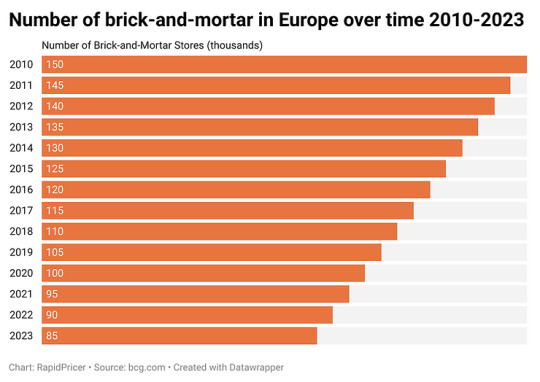
Figure: Number of brick-and-mortar in Europe over time

Figure: Department stores
Department stores: Department stores are large stores that sell a variety of products, such as clothing, home goods, and electronics. Some of the most famous department stores in Europe include Galeries Lafayette in Paris, Selfridges in London, and El Corte Inglés in Madrid.

Figure: Independent retailers
Independent retailers: Independent retailers are small, privately owned businesses that sell a variety of products. These retailers often have a strong local presence and offer a unique shopping experience.
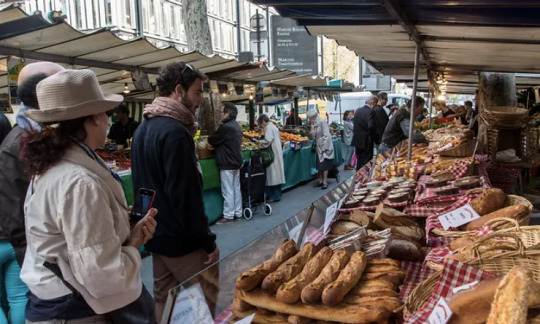
Figure: Markets
Markets: Markets are a great place to find fresh produce, meats, cheeses, and other local products. Many European cities have traditional markets that have been operating for centuries.

Figure: Outlet
Outlet malls: Outlet malls are a great place to find discounted name-brand clothing, shoes, and accessories. These malls are often located in tourist destinations.

Figure: Warehouse clubs
Warehouse clubs: Warehouse clubs are membership-only stores that sell a variety of products in bulk. These clubs are a great place to find discounts on groceries, household goods, and other items.
Traditional retail is still a major part of the retail landscape in Europe, and it is likely to remain so for the foreseeable future. These stores offer a unique shopping experience that cannot be replicated online. In addition, many traditional retailers are adapting to the changing retail landscape by investing in their online presence and offering omnichannel shopping experiences.
The European Retail Landscape
Europe boasts a diverse and rich retail heritage, with traditional shops, boutiques, and markets dating back centuries. These establishments have played a significant role in local economies, offering consumers a wide range of goods and personalized shopping experiences.
Challenges in the Digital Age: Traditional retail in Europe has felt the impact of the digital age. The rapid growth of e-commerce giants like Amazon, along with the convenience of online shopping, has led to a decline in foot traffic at brick-and-mortar stores. Consumers now have access to a vast array of products with the click of a button, making it essential for traditional retailers to adapt.
The Omnichannel Approach: Many traditional European retailers are responding to the digital challenge by adopting an omnichannel approach. This strategy combines physical stores with an online presence, offering consumers a seamless shopping experience. Retailers are investing in e-commerce websites, mobile apps, and in-store technology to bridge the gap between offline and online shopping.
Customer Experience and Personalization: One advantage traditional retailers have over e-commerce is the ability to provide a unique and personalized customer experience. Many European consumers still value the tactile, sensory experience of shopping in a physical store. Traditional retailers are focusing on creating welcoming and interactive environments, offering personalized service, and curating their product selections to cater to local tastes.
Sustainability and Localism: In response to consumer demand for sustainability and ethical shopping, traditional European retailers are emphasizing their commitment to local sourcing and environmentally friendly practices. Some are rediscovering the benefits of locally-produced goods, promoting them as eco-friendly alternatives to mass-produced items. This aligns with the rising trend of supporting local businesses and reducing the carbon footprint associated with global supply chains.
Cultural and Historical Significance: Traditional retail establishments often hold cultural and historical significance in European communities. Many have been in operation for generations, serving as cornerstones of local culture. These stores are cherished by residents and tourists alike, and efforts are made to preserve their historical authenticity while integrating modern retail practices.
Government Support: Some European governments recognize the importance of preserving traditional retail and are offering support through grants, subsidies, and regulatory measures. These initiatives aim to bolster traditional retail against the encroachment of e-commerce and maintain the vibrancy of city centers.
Conclusion
Traditional retail in Europe is at a crossroads. While it faces challenges from the digital age and changing consumer preferences, it also has unique advantages rooted in history, culture, and personalized shopping experiences. To thrive in today's retail landscape, traditional retailers must embrace technology, adopt an omnichannel approach, focus on customer experience, and align with sustainability and localism trends. In doing so, traditional European retail can not only survive but also continue to offer consumers a distinctive and cherished shopping experience that reflects the rich tapestry of Europe's retail heritage. By adapting to the evolving market while preserving their unique qualities, traditional retailers can continue to play a vital role in the continent's commercial landscape.
The changing demographics of consumers
The demographics of European consumers are also changing, which is having an impact on the retail landscape. The population is aging, with more people over the age of 65. This group is increasingly active and affluent, and they are looking for different products and services than younger consumers. They are also more likely to shop online.
Another demographic trend is the increasing diversity of the European population. This is leading to a demand for more ethnic food and clothing stores. Retailers are also adapting their marketing and advertising to reach these new customer groups.
Here are some specific examples of how the changing demographics of consumers are impacting the retail industry in Europe:
The aging population is leading to a demand for more accessible and convenient shopping options. This is driving the growth of online grocery delivery and click-and-collect services.
The increasing diversity of the population is leading to a demand for more ethnic food and clothing stores. This is also leading to a demand for products and services that cater to the needs of diverse cultures, such as halal food and bilingual customer service.
The rise of the digital native is leading to a demand for more personalized and engaging shopping experiences. This is driving the growth of mobile commerce and augmented reality (AR) shopping.
The changing role of women is leading to a demand for more flexible shopping hours and options for online shopping. This is also leading to a demand for more products and services that are designed for women, such as maternity clothing and baby products.
The growing importance of sustainability is leading to a demand for more sustainable products and services. This is driving the growth of organic food, fair trade clothing, and recycled packaging.
The increasing adoption of new technologies
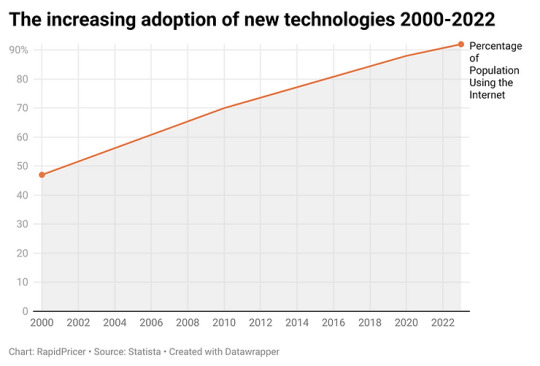
Figure: The increasing adoption of new technologies
As you can see, the percentage of people in Europe using the internet has been increasing steadily over the past two decades. This is due to a number of factors, including the increasing availability of high-speed internet, the falling cost of computers and smartphones, and the growing popularity of online services.
The increasing adoption of new technologies is having a major impact on the retail industry in Europe. Here are some of the key technologies that are being adopted by retailers in Europe:
Artificial intelligence (AI): AI is being used to improve a variety of tasks in the retail industry, such as customer service, inventory management, and fraud detection. For example, AI can be used to analyze customer data to personalize recommendations, or to predict which products are likely to be in high demand.
Augmented reality (AR): AR is being used to create immersive shopping experiences that allow customers to try on clothes virtually or see how furniture would look in their home. For example, IKEA has an AR app that allows customers to see how its furniture would look in their living room.
Virtual reality (VR): VR is being used to create even more immersive shopping experiences that allow customers to virtually visit stores and try on products. For example, Amazon has a VR store that allows customers to browse its products and make purchases.
Internet of Things (IoT): IoT is being used to connect devices and collect data about customer behavior. This data can be used to improve a variety of tasks, such as inventory management and customer service. For example, retailers can use IoT sensors to track the movement of products in stores and to identify when products are running low.
Blockchain: Blockchain is being used to create secure and transparent supply chains. This can help retailers to ensure the authenticity of their products and to track their products from the source to the customer. For example, Walmart is using blockchain to track the supply chain of its food products.
These are just some of the key technologies that are being adopted by retailers in Europe. The adoption of these technologies is helping retailers to improve their efficiency, personalize the customer experience, and create a more sustainable supply chain.
E-Commerce Dominance
One of the most profound shifts in European retail has been the rise of e-commerce. Consumers now have the convenience of shopping online from the comfort of their homes, and this trend has been accelerated by the COVID-19 pandemic. Major players like Amazon, Alibaba, and local champions such as Zalando and ASOS have expanded their reach across Europe, reshaping consumer behavior and expectations. Retailers have had to invest heavily in their online presence, enhancing websites, mobile apps, and supply chain logistics to meet the demand for digital shopping. Additionally, omnichannel strategies have become essential, allowing consumers to seamlessly switch between online and offline shopping experiences.
E-commerce dominance refers to the growing market share of online retailers over traditional brick-and-mortar stores. This trend is being driven by a number of factors, including the increasing availability of high-speed internet, the growing popularity of mobile shopping, and the convenience of online shopping. In Europe, e-commerce sales are expected to reach €768 billion in 2022, accounting for 16.1% of total retail sales. This growth is being driven by the increasing adoption of online shopping by consumers across all demographics.
There are a number of reasons why e-commerce is becoming so dominant. First, the availability of high-speed internet has made it possible for consumers to shop online quickly and easily. Second, the popularity of mobile shopping has made it possible for consumers to shop online from anywhere. Third, the convenience of online shopping is unmatched by traditional brick-and-mortar stores. Consumers can shop online 24/7, compare prices from different retailers, and have products delivered to their door. The rise of e-commerce is having a major impact on the retail industry. Traditional brick-and-mortar stores are facing increasing competition from online retailers, and many are struggling to compete. In order to survive, traditional retailers need to adapt to the changing retail landscape by investing in their online presence and offering omnichannel shopping experiences.

Figure: Share of online retail sales in Europe over time
As you can see, the share of online retail sales in Europe has been increasing steadily in recent years. This is due to the increasing popularity of online shopping, which is more convenient and offers a wider selection of products. The share of online retail sales is expected to continue to increase in the coming years. However, it is important to note that not all countries are affected equally. For example, the share of online retail sales is higher in Northern Europe than in Southern Europe. The future of online retail in Europe is bright. The growth of online shopping is being driven by a number of factors, including the increasing availability of high-speed internet, the growing popularity of smartphones and tablets, and the increasing convenience of online shopping.
Sustainability and Ethical Consumption
The European retail landscape is witnessing a significant shift towards sustainability and ethical consumption. Consumers are becoming increasingly aware of the environmental and social impact of their purchases. Retailers are responding by adopting eco-friendly practices, sourcing sustainable products, and promoting transparency in their supply chains.
Fashion brands, in particular, have made strides in sustainable fashion, with initiatives like "slow fashion" and clothing rental services gaining popularity. European consumers are favoring products that are produced responsibly and have a lower environmental footprint, and retailers are aligning their strategies with these values.
Personalization and Data Analytics
Data analytics and artificial intelligence are playing a crucial role in the transformation of European retail. Retailers are harnessing the power of big data to gain insights into consumer behavior, preferences, and shopping habits. This data-driven approach allows them to personalize marketing efforts, optimize inventory management, and enhance the overall shopping experience.
Personalized recommendations, targeted advertising, and tailored promotions are becoming the norm in the industry. Retailers are using predictive analytics to forecast trends and adjust their product offerings accordingly, ensuring they stay ahead of consumer demands.
Pop-Up Stores and Experiential Retail
While online shopping continues to grow, physical stores are not becoming obsolete. Instead, retailers are reimagining the in-store experience to attract and engage customers. Pop-up stores and experiential retail spaces are gaining popularity, offering unique and immersive experiences that cannot be replicated online.
These temporary stores allow retailers to test new products and connect with customers on a more personal level. They often incorporate interactive elements, such as virtual reality experiences or live demonstrations, to create memorable moments for shoppers.
Cross-Border Expansion
European retailers are increasingly looking beyond their home markets for growth opportunities. Cross-border expansion has become a viable strategy for many companies seeking to tap into new customer bases and diversify revenue streams. The European Union's single market has facilitated this expansion by reducing trade barriers and harmonizing regulations.
Furthermore, technology has made it easier for retailers to reach international customers through e-commerce platforms and digital marketing. As a result, many European brands are expanding their presence into neighboring countries and even outside of Europe, creating a more competitive and globalized retail landscape.
Post COVID European Retail
The retail industry in Europe is undergoing a period of change after COVID. The pandemic has accelerated the shift to online shopping, and brick-and-mortar stores are struggling to compete. Retailers are responding by adopting new technologies, such as AR and VR, and by offering more convenient shopping experiences, such as BOPIS. The industry is also focusing on sustainability, as consumers are increasingly demanding sustainable products and services.
Conclusion
The changing landscape of European retail is characterized by the rapid growth of e-commerce, a focus on sustainability and ethical consumption, data-driven personalization, experiential in-store experiences, and cross-border expansion. Retailers that adapt to these trends and embrace digital transformation are likely to thrive in this dynamic environment.
The future of European retail will continue to be shaped by evolving consumer preferences and technological innovations. To stay relevant, retailers must remain agile, customer-centric, and committed to ethical and sustainable practices. As the industry continues to evolve, it will be exciting to see how retailers innovate and compete in this ever-changing landscape.
About RapidPricer
RapidPricer helps automate pricing, promotions and assortment for retailers. The company has capabilities in retail pricing, artificial intelligence and deep learning to compute merchandising actions for real-time execution in a retail environment.
Contact info:
Website: https://www.rapidpricer.com/
LinkedIn: https://www.linkedin.com/company/rapidpricer/
Email: [email protected]
#European Retail Industry#Retail Trends in Europe#E-commerce Growth#Brick-and-Mortar Stores#Omnichannel Retailing#Digital Transformation#Consumer Behavior#Sustainability in Retail#Retail Technology#Online Marketplaces#Supply Chain Disruptions#Post-Pandemic Retail#Retail Innovation#Mobile Shopping#Data Analytics in Retail#Cross-Border Shopping#Pop-Up Stores#Customer Experience#Retail Competition#Retailer Partnerships#Retail Regulations#Future of Retail in Europe#Retail Challenges#Local vs. Global Retailers#Retail Adaptation Strategies
0 notes
Text
youtube
Watch the American Climate Leadership Awards 2024 now: https://youtu.be/bWiW4Rp8vF0?feature=shared
The American Climate Leadership Awards 2024 broadcast recording is now available on ecoAmerica's YouTube channel for viewers to be inspired by active climate leaders. Watch to find out which finalist received the $50,000 grand prize! Hosted by Vanessa Hauc and featuring Bill McKibben and Katharine Hayhoe!
#ACLA24#ACLA24Leaders#youtube#youtube video#climate leaders#climate solutions#climate action#climate and environment#climate#climate change#climate and health#climate blog#climate justice#climate news#weather and climate#environmental news#environment#environmental awareness#environment and health#environmental#environmental issues#environmental justice#environment protection#environmental health#Youtube
16K notes
·
View notes
Text
What I am Learning About Learning!
I am a learner. If you don’t know where that comes from, let me tell you because I am a firm believer in Gallup Cliftons’ Strengthfinders theory and practice in the workplace especially but really in all of life’s spaces!
If you do not know your top 5 strengths, I highly urge you to go here (this is the free unofficial version) right now before you read any further. If your a learner like me,…

View On WordPress
#boys#brick and mortar#Children#competition#conformity#creativity#curiousity#Education#educators#exploration#factory workers#Gallup Strengthfinders#Homeschooling#Learning#learning environments#learning style#parenting#Private school#public school#strenghts#Zach Lahn
0 notes
Text
More Often
Earth 42!Miles Morales x fem!reader
Earth 42!Miles Morales x black!reader
Word Count: 1.3k
Warnings: Mentions of water guns and mentions of jellyfish
Requested: yes
@raeraypoca:That's perfect smanks! So basically all I would like is what happens on the road trip over there, stopping at gas station, what happens when we get to the Airbnb, what happens at the beach, classic "we gotta share a room?
Ughh" E, when we're left alone some heavy fluffy flirting only if your comfortable. I know miles is 15 l'm 14 so you really don't have to if you don't want to. A trip Possibly somewhere in Florida?
A/N: Life has been crazy lately but I did enjoy my social media detox, I wanted to get this out sooner but I got into a car accident on Friday and I was supposed to hang out with this girl I've been talking to today but I had no car and I look crazy but, this is here now so that's all that matters.
Masterlist



“Be good,” Mrs. Morales warned.
“I will,” Miles ceded.
She looked him in his eyes in suspicion.
“I promise,”
She smiled “Okay come give me a kiss,”
He kissed and hugged his mother goodbye before putting his suitcase in the trunk. He rounded the car to your side pulling the door open
“Go on the other side,” You didn’t even look up from your phone.
“Scoot over,” He shoved your shoulder.
“14 hours of this?” You rolled your eyes.
“You love me,” He teased as you slid into the other seat to make room.
Your older brother was going on a college visit up in Florida so your mom decided to make a family trip out of it. Of course, she invited Miles seeing as he was practically family. And who was he to say no to Mrs. Y/L/N?
After only 4 stops and one-half a night at a hotel, you’d finally made it to Destin.
Your mom parked the car in between two brick-and-mortar shops on the uneven beach town roads.
You immediately popped the door open hoping out to stretch your legs. Your brother got stuck with the pleasure of having to “watch” you and Miles on the Harborwalk Village pier, while your parents went sightseeing. He told you not to go too far before heading off on his own.
“Look!” You pointed at a carnival game booth run by a tired and probably only a few years older than you teenager who certainly didn’t get paid enough. There at the top of a booth hung a very large dog stuffed animal with light blue fur and a purple collar.
You tugged Miles along with you beaming at the boy. He coughed up the 5 dollars required for the both of you to get to fill balloon clowns' heads with water guns.
On an unenthusiastic count of 3, you aimed your gun at the first clown’s mouth and pulled the trigger.
Powered by your competitive spirit you quickly overtook Miles in the vanquishing of the clowns. His water gun consistently jamming was cause for frustration and his loss.
“Game was rigged,” He informed you.
“Okay, Trump. You’re only saying that ’cause I won” You clutched your stuffed dog winnings.
“‘M saying that cause it’s true,”
“I’m saying that ‘cause it’s true,” You mocked him in a high-pitched voice sticking your tongue out. “What are we gonna name our son?”
“He is not my son,”
You gasped, shifting the dog to cover his floppy ears with both hands. “Don’t say that in front of him!”
Completely ignoring him you turned away from Miles to cradle the stuffed animal. “I’m sorry Miles Jr. I don’t know what’s gotten into your dad today. He doesn’t mean it,”
You handed the toy to Miles telling him to apologize. He glared at you for the name before mumbling a half-hearted sorry to the dog.
He couldn’t believe he actually liked you enough to apologize to a stuffed animal named after him.
“Thank you,” You smiled before spotting a sandwich shop a little way down the boardwalk.
“C’mon Miles, Junior,”
“Why are you making me hold this thing?” He complained, glancing around at the other passersby on the pier.
“He is not a thing.” You readjusted Junior in Miles’s arms to be cradled like a baby.
You continued walking down to Say Cheese situated at the end of the boardwalk occasionally glancing back to make sure Miles was still holding the stuffed animal the way you gave it to him.
——————
“Stop!” You complained, shielding your sandwich from the onslaught of sand coming your way.
Miles kept shoveling sand at you with both hands. “C’mon let’s go make a castle.”
“Let me eat,”
“How are you still hungry with all the snacks you ate in the car?”
“You ate all the chips,” You retaliated with a swoop of sand sent his way. “I only ate like two”
“Yeah, two whole bags,”
“Shut up,” You reached your hand out to be pulled up from the ground.
Back on your feet as you made the trek down shore you leaned into his side. You hissed when you stepped on a sideways seashell.
He came to a stop jolting you back with him.
“You alright? Was it a jellyfish?”
You drew up your face at that. “Why would there be a jellyfish all the way back here?”
“You could’ve just said you’re fine,”
“Okay sorry I’m fine, c’mon,” You tugged his arm with you.
Finding a good spot between the water and shore you dropped down to form your sand castle.
You waited until Miles joined you on the ground to scoop the viscous textured sand into your hands and stack towers of the sand on top of Miles’s.
When you turned to find seashells to top off your pillars Miles knocked over half the castle.
“Miles!” You shrieked pushing him down.
He pulled you down with him, laughing at you. You couldn’t suppress your giggles as you wrestled with Miles in the sand.
You were ready to pummel him with sand when you heard your mother call out for you.
“Y/N! Miles! We’re leaving!”
After racing and losing against Miles back to the rental car your mom turned you around. “Uh uh get that sand off you,”
You rolled your eyes heading for the showers to rinse off.
After cleansing the dusting the sand off yourself, in no time you were knocked out in the backseat of the car.
You woke up past the sunset to a quick flash.
You whined seeing your mother with her phone in your face from the passenger seat.
You were entangled with Miles who was somehow still asleep. You shook him awake before getting out of the car yourself.
—————
When you found out you’d be staying in the same room
You jokingly complained, “He snores like he has 5 kids and works 2 jobs?”
“Be nice,” Your mother chastised. “He’s our guest,”
“Yeah, be nice,” He teased.
You punched him in the shoulder before lugging your suitcase out of the trunk.
As you reached back in the trunk to grab your duffle bag, Miles grabbed the handle of your suitcase.
“How many bags did you bring?” He questioned.
“I can carry them, then,” You stressed.
“No,” He grabbed your other bag. “I got it,”
“Alright,” You slammed the trunk down before following Miles up the front steps of the AirBnB.
——————
“Do you think-” You heard through the darkness.
“Oh my God! No. Don’t say anything, go to sleep,”
This wasn’t the first sleepover you had with Miles and it wouldn’t be the last, and almost every time without fail he would start spouting nonsense once the clock hit the AMs.
“I was just gonna say what if dogs have existential crises?”
“How would I know that?”
He shrugged despite it being only light enough for you to see his general silhouette.
The exact moment you flipped back over to try to sleep, Miles interrupted you again.
“Wanna watch The Road to El Dorado with me?”
Knowing you weren’t going to be able to fall asleep now, you loudly sighed before agreeing and sitting up against the headboard.
He unplugged his phone from the bedside table resting between the beds, before getting up.
You pulled the comforter back to give him space to climb in next to you.
He grabbed Junior moving to put him on the floor.
“No, don't put him on the ground,” You whined.
“He’s staring at me,”
You strained to lean over Miles and pick the toy back off the ground. You put the stuffed animal back on the bed so you were sandwiched between it and Miles.
Then sidled up to Miles’s arm leaning on his shoulder.
Not even five minutes into the movie, he felt you aggressively yawn, before burying your face in his shoulder.
Soon your breathing evened out and when he glanced over you were asleep.
He smiled to himself before pausing the movie at the barrel jump scene, moving so you were lying down.
He put your phone on the charger and ensured you were tucked in before placing a kiss on your forehead.
“Good night,” He whispered before lying down himself, ready to hang out with you more in the morning.

©guessimjoiningthespidermanfandom
#hannah speaks ღ#hannah responds ღ#earth 42 miles morales x black!reader#miles morales x reader#earth 42#earth 42 miles morales x reader#earth!42 miles morales x reader#earth 42 miles x you#earth 42 miles x reader#miles morales x black!reader#miles morales fanfiction#miles morales#earth 42 miles morales#miles morales angst#miles morales fluff#miles morales fic#miles morales x fem!reader#into the spider verse#across the spiderverse#earth 1610 miles morales x reader#1610 miles x reader#prowler miles#prowler!miles x reader#prowler!miles
224 notes
·
View notes
Text
divus crewel x reader (headcanons/fic)
pairing: Pomefiore housewarden! crewel x vice-housewarden! reader (gn! reader, reader is not yuu)
content: rivals to lovers, fluff
word count: ~1800
With eyes on the position of housewarden, you and Crewel are locked in a rivalry. Headcanons for your ever-changing relationship during the academic year.

It was preposterous. You didn’t want to accept this loss. The poison that Crewel brewed was barely any better than yours. When the headmage announced the winner of the competition, and consequently the unchanging Pomefiore housewarden, you wanted to protest. You held back any remarks, forced a smile, and shook his hand.
(Deep inside, you knew, Crewel did deserve the win. He was just slightly more precise. You were watching him the whole time- His intuition of when to add each ingredient was sharp and his assessment of his potion’s potency was better than yours. You’d rather drink your own potion and his than let him know, though.)
ㅤㅤㅤㅤㅤㅤㅤㅤㅤㅤㅤㅤㅤㅤㅤㅤㅤㅤㅤㅤㅤㅤㅤㅤㅤㅤㅤㅤㅤㅤㅤㅤㅤㅤㅤㅤㅤㅤㅤㅤ
With no time to recover from your loss, Crewel had already approached you again, insisting to talk. You reluctantly agree. He’s a third-year-- not a good idea if you were to get on his bad side now.
He appointed you as vice-housewarden, to your great dismay. It felt insulting -- if this position wasn’t earned by your own skill, did it really mean anything? It was gifted to you by your rival, no less!
“It’s because of your talent in potionology, and you're only in your second year,” Crewel had said, with that annoying smirk of his. “I couldn’t see anyone else more fitting to lead Pomefiore with me.” You knew he was lying. The closer you were to him the more he was able to monitor you. He’s pulling at strings so you won’t beat him to Housewarden.
You smile, feigning cooperation. Two can play this game. The closer you were to him the easier it is to find his weakness - unravel the threads of his character - break him down.
“It would be a great honor to serve as your vice-house warden,” you bite back. The smile that played on your lips was no more than a friendly forefront, and you knew he knows that too.
ㅤㅤㅤㅤㅤㅤㅤㅤㅤㅤㅤㅤㅤㅤㅤㅤㅤㅤㅤㅤㅤㅤㅤㅤㅤㅤㅤㅤㅤㅤㅤㅤㅤㅤㅤㅤㅤㅤㅤㅤ
From an outsider’s perspective, the two Pomefiore housewardens get along well enough. As expected, you both represent Pomefiore’s in-campus events and student meetings. There was enough cooperation in keeping your dorm’s reputation in check.
If one were to look a bit closer, one might notice the hostile attitude that seeped through both of your interactions.
An unnecessary remark here and there-- “Rewrite this proposal form- your wording is nothing but confusing”, “you’re uniform is crooked, and you call yourself the housewarden?” -- done for the sole reason of riling each other up.
ㅤㅤㅤㅤㅤㅤㅤㅤㅤㅤㅤㅤㅤㅤㅤㅤㅤㅤㅤㅤㅤㅤㅤㅤㅤㅤㅤㅤㅤㅤㅤㅤㅤㅤㅤㅤㅤㅤㅤㅤ
It’s another story within the walls of the Pomefiore residence, though. The other students are no strangers to their housewardens’ bickering.
“We are not calling the headmage back to supervise another duel this month,” Crewel would tell you after your persistent nagging. He smiles snarkily, closing the distance between you both - faced merely inched away from each other.
“And, is another duel really worth it when you’ve barely improved? The results won’t change~”. You watch him walk away, his robe swaying. “Don’t forget about the meeting tomorrow, pup,” he calls back to you, not turning around.
Pup? What does that even mean? You’re Irritated, yet you leave it at that.
ㅤㅤㅤㅤㅤㅤㅤㅤㅤㅤㅤㅤㅤㅤㅤㅤㅤㅤㅤㅤㅤㅤㅤㅤㅤㅤㅤㅤㅤㅤㅤㅤㅤㅤㅤㅤㅤㅤㅤㅤ
As the semester goes on, you both butt heads less. Not that you’ve given up on taking Crewel down, no. School works just sometimes gets in the way.
Sometimes you’d be in the Pomefiore labs, practicing some recipes when you get unwanted company.
“The recipes call for crushed dawn-weeds, and those are not crushed enough.” You flinch, almost dropping your mortar, whipping your head around to see Crewel watching you with his arm crossed.
“And your cauldron is not hot enough,” he continues, walking over to observe your concoction a bit closer—his shoulder brushes against yours.
You huff, really not wanting to deal with this right now. “What, miss me so much you’ve come after me, Crewel?”
“Just checking to see if you’ve given up on being Housewarden or not,” Crewel responds. “Add the dawn-weed now, it’s at boiling level.”
You oblige. If he’s going to start tutoring you now you’ll make sure he regrets it in the end when you take his position away from him.
(The potion ended up being perfect according to your potionology professor. You reluctantly take the compliment and burn Crewel’s advice into your brain for later.)
ㅤㅤㅤㅤㅤㅤㅤㅤㅤㅤㅤㅤㅤㅤㅤㅤㅤㅤㅤㅤㅤㅤㅤㅤㅤㅤㅤㅤㅤㅤㅤㅤㅤㅤㅤㅤㅤㅤㅤㅤ
You started seeing Crewel more often whenever you are in the lab. Sometimes he’s there to work, other times he seemed to have come just to debate with you. Today, he was working on an assignment. You’ve both fallen into a rhythm - moving around the room quietly, minding your own business.
“Do you have the cherry seeds?” You hear Crewel call from his side of the room. You hum in acknowledgment, going back to your work. Footsteps echoing in the distance let you know he was heading over.
He’s suddenly leaning over your shoulder, his face so close to your own-- you can smell the cologne he’s wearing. It’s musty, yet sweet… there are too many notes you couldn’t describe. He picks up the vial of cherry seeds in front of you and as he pulls back, you made eye contact. Ah, shit- was it that obvious you were staring?
As he’s heading back to his workstation, you wonder to yourself why your cheeks were so warm. He’s just an acquaintance- no- a rival… right? Why is your heart beating faster than usual?
(You shake off the feeling, getting back to your work. Still distracted, you accidentally spilled the concoction you had made.)
ㅤㅤㅤㅤㅤㅤㅤㅤㅤㅤㅤㅤㅤㅤㅤㅤㅤㅤㅤㅤㅤㅤㅤㅤㅤㅤㅤㅤㅤㅤㅤㅤㅤㅤㅤㅤㅤㅤㅤㅤ
Yet another duel passes… and you lost. Again. Not that this was new, but something deep in your heart is beating you up over this loss particularly. Why weren’t you improving? More than half the school year has gone by now.
It was late at night, and you were cooped up in the lab. The poison you had made… where did it go wrong this time? Did you let it boil too long? Did that denature the enzymes so the reaction failed? Or did you--
“Are you here, pup?”. Ah, that voice. You would rather not talk now, thank you.
“Crewel, I’d really rather not deal with you now,” You mumble. The hostility in your voice was lost long ago, Fatigue setting in.
“The headmage wanted to see us housewardens before classes tomorrow. You should be in bed… Or are you going to sit and wallow in your loss like this?” He asks. Ouch. He knew exactly what you were thinking.
As much as his comment hits you, it also snapped you out of your slump. “Like hell I am,” you say, pushing yourself up from the desk. Crewel’s right, there are things to do rather than regret something that already passed.
When you pass him on the way out, he gives your hair a quick ruffle. “You are improving, you know? It’s getting harder and harder each time to come up with recipes to beat you.” You feel his hand linger for a while before he lets go. You fall in step with each other, before splitting off into your own rooms, both sharing a word of ‘good night’’.
ㅤㅤㅤㅤㅤㅤㅤㅤㅤㅤㅤㅤㅤㅤㅤㅤㅤㅤㅤㅤㅤㅤㅤㅤㅤㅤㅤㅤㅤㅤㅤㅤㅤㅤㅤㅤㅤㅤㅤㅤ
Sometimes you wonder if the events from that night did happen. It must have, though. Your relationship with Crewel had changed- you can tell. There’s much less bitterness, and in a way, you feel as though you understand him a bit better. You hope he thinks the same about you, too.
Crewel would show up less to the labs, but there wasn’t anything strange about that. The third-years had both exams and internships to prepare for. When he does show up, however, he spends much more time with you- hanging around your workstation, offering a comment or tip, and sometimes going out of his way to give you his own notes.
You’ve decided now. On the final week of the NRC term, you’ll ask for one more duel. A final one to close out your year with Crewel. And this time you will win. Crewel accepts your challenge as soon as he hears of it.
ㅤㅤㅤㅤㅤㅤㅤㅤㅤㅤㅤㅤㅤㅤㅤㅤㅤㅤㅤㅤㅤㅤㅤㅤㅤㅤㅤㅤㅤㅤㅤㅤㅤㅤㅤㅤㅤㅤㅤㅤ
Get the water to a boil, then add the crushed-dawn weeds. Mix until the liquid is opaque. Add the cherry seeds between stirs. Then lower the heat. The recipe you’ve practiced and practiced was carried out with absolute precision-- your hours in the lab finally coming to fruition. You glance over to Crewel, who was also wrapping up his brew.
With both your works presented to the headmage for assessment, you can wait impatiently for the results.
When the headmage calls your name as the winner, it snaps you out of your spiraling thoughts. Wait, did actually say your name just now?
You turn to Crewel, and he nods, offering a celebratory applause before holding his hand out. You take it, suddenly pulling into a hug. There’s a strangled yell from Crewel when you wrap your arms around his, but you feel him hugging you back shortly.
“Congratulations, my dear vice-housewarden,” He says only for you to hear. “Or should I say my housewarden?”.
(Breaking from the hug, you regain your composure. The adrenaline from your win buries the feeling of embarrassment from hugging him. It comes back to bite later on).
ㅤㅤㅤㅤㅤㅤㅤㅤㅤㅤㅤㅤㅤㅤㅤㅤㅤㅤㅤㅤㅤㅤㅤㅤㅤㅤㅤㅤㅤㅤㅤㅤㅤㅤㅤㅤㅤㅤㅤㅤ
“What are you planning on doing for your fourth year?”. Standing on the balconies of the dorm, Crewel is next to you, resting his weight on the concrete railing. He shrugs, eyes lingering on the evening sun that marked the last day of your school year.
“I’ve been scouted by some companies as a fashion designer,” He says. You laugh.
“And here I thought you’d go be a teacher or something- after all those times with you in the labs where’d you drill recipes into my head. Well, maybe that’s for the better. I don’t want you bullying the kids.”
Crewel chuckles. “Training the next generation’s puppies, huh? I’ll take that into consideration”. You feel the weight shift next to you as Crewel turns to face you. Something heavy falls upon your head, and you move your hand to touch it. It was smooth and solid-- your fingers brush over the crevices and engraved details. Could this be?
“The housewarden’s crown,” Crewel answers for you, adjusting it on your head. When he was done, he steps back. A small smile graces his face as your eyes met his. “Take care of this for me, will you? You deserve it.”
“With my pleasure,” you respond, smiling back. This time, Crewel is the one who pulls you into an embrace. You take the time to cherish it-- your interactions, your bickering… the connection you’ve built with him. It will be hard imagining next year with him, but that’s a problem for later. For now, theres only you, and him.

this was going to be short, but then I kept writing more :,) I was struggling to end this somewhere, hopefully it makes sense ^^
148 notes
·
View notes
Text

𝖙𝖍𝖊 𝖌𝖍𝖔𝖚𝖑𝖘 𝖆𝖑𝖑 𝖈𝖆𝖒𝖊 𝖋𝖗𝖔𝖒 𝖙𝖍𝖊𝖎𝖗 𝖍𝖚𝖒𝖇𝖑𝖊 𝖆𝖇𝖔𝖉𝖊𝖘 . . .
date: october 13th, 2023
address: to be sent upon rsvp
time: 9pm sharp
attire: your ghouliest costume
happy early halloween, rock bottom! here's your formal invite to our agency sponsored halloween party. you'll be spending your evening in a stunning mansion and villa perched above the sunset strip. with incredible views of los angeles below, you guys will be able to enjoy a night of music, dancing, food, and drinks in near total privacy. the pool is heated year round for those who might want to spend some time underwater and the in-home movie theatre will be playing a nonstop selection of horror films for those who might want to get away from the noise to snuggle up with a jump scare or two. various games, spanning from classic competitive drinking games to just straight up brick and mortar board games will be available throughout the home as well.
a wide selection of food and drink will be offered, of course, spanning across every possible dietary need ( vegans, we see you ) and sobriety level ( we've stepped up our mocktail game, trust us ) to make sure that everyone in attendance is well taken care of and able to enjoy the night to the fullest.
jersey's own dj diesel ( who some of you may better know as shaquille o'neal ) will be spinning a live set for us all night...and if you ask us, that's the part we might be most excited about. showing up in costume is required to attend this party, and we'll be having a costume contest for those who are itching to go all out and get their spooky, creative juices flowing or bring their cosplay to life for halloween. more information will be available shortly on how to submit your costumes for the evening and exactly how to cast your votes for your favorites!
in order to rsvp, please simply just reply to this post with your favorite halloween-themed emoji and we'll do the rest from there!
70 notes
·
View notes
Text
youtube
Watch the 2024 American Climate Leadership Awards for High School Students now: https://youtu.be/5C-bb9PoRLc
The recording is now available on ecoAmerica's YouTube channel for viewers to be inspired by student climate leaders! Join Aishah-Nyeta Brown & Jerome Foster II and be inspired by student climate leaders as we recognize the High School Student finalists. Watch now to find out which student received the $25,000 grand prize and top recognition!
#ACLA24#ACLA24HighSchoolStudents#youtube#youtube video#climate leaders#climate solutions#climate action#climate and environment#climate#climate change#climate and health#climate blog#climate justice#climate news#weather and climate#environmental news#environment#environmental awareness#environment and health#environmental#environmental issues#environmental education#environmental justice#environmental protection#environmental health#high school students#high school#youth#youth of america#school
16K notes
·
View notes
Text
How Amazon transformed the EU into a planned economy
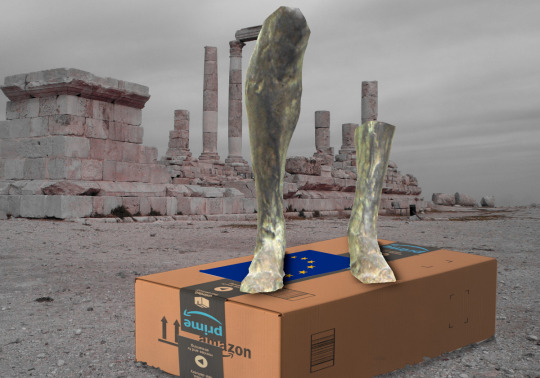
Amazon is a perfect parable of enshittification, the process by which platforms first offer subsidies to end users until they’re locked in, then make life good for business customers at users’ expense, until they’re locked in, then claw back all the value they can for themselves, leaving just enough behind to keep the lock-in going.
In a new report for SOMO, Margarida Silva describes how the end-stage enshittification of Amazon is playing out in the EU, with Amazon repeating its US playbook of gouging the small businesses who have no choice but to use the platform in order to reach its locked-in customers, making European customers and European sellers poorer:
https://www.somo.nl/amazons-european-chokehold/
The mechanism for this isn’t a mystery. Amazon boasts about it! They call it their flywheel: first, customers are lured into the platform with low prices, especially through Prime, which requires pre-payment for a year’s shipping, which virtually guarantees that customers will start their shopping on Amazon. Because customers now start their buying on Amazon, sellers have to be there. The increased range of goods for sale on Amazon lures in more buyers, who lure in more sellers, with both sides holding each other hostage:
https://vimeo.com/739486256/00a0a7379a
This flywheel creates a vicious cycle, starving local retail so that customers can’t get what they need from brick-and-mortar shops, which funnels sellers into offering their goods for sale on Amazon. The less choice customers and sellers have about where they shop, the more Amazon can abuse both to pad its own bottom line.
There are 800,000 EU-based sellers on Amazon, and they have seen the junk-fees that Amazon charges them skyrocket, to the point where they have to raise prices or lose money on each sale. Amazon uses both tacit and explicit “Most Favored Nation” deals to hide these price-hikes. Under an MFN deal, sellers must not allow their goods to be sold at a lower price than Amazon’s — so when they raise prices to cover Amazon’s increasing fees, they raise them everywhere:
https://pluralistic.net/2023/04/25/greedflation/
It’s not hard to understand why Amazon would raise its fees: the company has an effective e-commerce monopoly. Like Ozymandias, they have run out of worlds to conquer, and so their growth has to come from squeezing suppliers and/or raising prices, not from bringing in new customers. This is likewise true of mobile companies like Apple and Google, who have run out of people who are so excited about incremental mobile hardware gains that they’ll buy a new phone every year, which means that growth has to come from squeezing app vendors:
https://www.tbray.org/ongoing/When/202x/2023/06/09/Pixel-4-to-7
This is likewise true of the streaming companies, which is why Netflix is cracking down on “password sharing”:
https://pluralistic.net/2023/02/02/nonbinary-families/#red-envelopes
It’s true of the movie studios, which is why they want to zero out their wage bills by replacing writers with automatic plausible sentence generators that will write stupid movies that they think we’ll still pay to see because there won’t be anything else:
https://pluralistic.net/2023/05/06/people-are-not-disposable/#union-strong
It’s certainly true of Uber, which is why they’ve double the cost of a taxi ride and halved the wages they pay drivers:
https://pluralistic.net/2023/04/12/algorithmic-wage-discrimination/#fishers-of-men
Monopolies “grow” by making their customers and suppliers worse off. But they have to be careful about this: if it’s obvious that you’re using your market power to screw buyers, you can get in trouble with competition regulators. That’s because the only part of antitrust law that the neoliberal project left intact is “consumer welfare” — the idea that monopolies should only face enforcement when they raise prices and/or lower quality:
https://pluralistic.net/2022/10/10/play-fair/#bedoya
This focus on price-hikes has given monopolists a free hand to squeeze suppliers and workers, because a monopolist — from Walmart to Amazon — can claim that squeezing your workers and suppliers is necessary to enhancing consumer welfare. The less you pay to produce a product, the cheaper you can price it.
When a company has a lot of seller power, we call it a monopolist. When it has a lot of buying power, we call it a monopsonist. No one ever made a bestselling, family-destroying board game called “Monopsony” so most people haven’t heard of the concept. But monopsony is every bit as dangerous as monopoly, and monopsonists find it far easier to acquire market power than monopolists. Few suppliers can afford to have even 10% of their sales disappear overnight, so a buyer who accounts for 10% of your sales can demand deep discounts and other favorable terms.
Amazon is a monopolist, but it’s also a very powerful and ruthless monopsonist. For example, its audiobook division, Audible, has a 90+% market-share, and it used that market-power to steal at least $100m from audiobook creators, in a scandal dubbed Audiblegate:
https://pluralistic.net/2022/09/07/audible-exclusive/#audiblegate
For Europe’s 800k sellers who rely on Amazon to reach their customers, the monoposony conditions are blatant and shameless. Take listing fees: Amazon’s “flywheel” pitch claims that as the company grows, it achieves “economies of scale” that can lower its cost basis. But Amazon’s listing fees haven’t changed, even as the company experienced explosive growth in the EU (remember, sellers whose Amazon fees exceed their margins have to pass those fees onto buyers, and also raise their prices everywhere else to satisfy the Most Favored Nation requirement).
Amazon books the revenues from these fees — and other junk-fees it extracts from sellers — in Luxembourg, an EU member nation that provides a tax haven to multinational businesses that want to maintain the fiction that they operate their businesses out of the tiny kingdom. There is sharp competition in the EU to offer the most servile, corrupt environment for multinationals, and Luxembourg is a leader, along with Cyprus, Malta and, of course, Ireland:
https://pluralistic.net/2023/05/15/finnegans-snooze/#dirty-old-town
But at least listing fees haven’t gone up, unlike other fees, which have climbed sharply. Amazon falsely claimed that its additional revenues from fees were the result of growth by independent sellers, which Amazon pegged at 65%. Later, the company admitted that the true growth figure was 22%. Meanwhile, fees are up 85%.
The true growth figure might be lower still. Amazon refuses to show the math behind its growth figures, or even say which sellers and sales are included in the figure.
The SOMO report cites research by Juozas Kaziukėnas of the e-commerce research firm Marketplace Pulse, who finds that sellers are now giving 50% of their gross revenues to Amazon, an increase of 10% over the past five years across the whole EU. However, different EU (and ex-EU) countries have experienced much steeper increases in fees — in the UK, fees have nearly doubled (up 98%), and in France, fees more than doubled (up 115%).
Many of these increases come from the Fulfilment By Amazon (FBA) program, which is promoted as an optional service, but which is really obligatory — careful research shows that sellers who warehouse, pack and ship their own goods get banished to the depths of search results, even if they have ratings, costs and times that are competitive with FBA. This is especially true of the “buy box” that lands at the top of most searches. The company refuses to disclose how buy box positioning is determined, but 90% of products in the buy box pay for FBA.
Amazon has used excuseflation to hike its FBA prices, blaming higher energy prices for price hikes that predated the Russian invasion of Ukraine, and blaming covid for price hikes that predated the pandemic.
Italy’s competition authority did yeoman service in uncovering the sleaze of FBA, publishing an investigation that showed that Prime and buy box made the notionally “optional” FBA into a must-have for merchants, meaning that Amazon could jack up FBA prices without losing business.
Another notable source of gouging came in response to the UK and France adopting digital services taxes, which were meant to make up for the tax-base erosion enabled by Luxembourg’s flouting of EU tax law. Amazon passed these taxes straight through to its merchants, without seeing a comparable decrease in the number of sellers using its platforms — an unmistakable sign of market power. If you can raise prices without losing customers, then, by definition, your customers have nowhere else to go.
I’ve previously written about how Amazon’s $31b/year “advertising” market isn’t really advertising — rather, it’s a payola scheme that auctions off the top of a search-listing to the merchant with the most to spend:
https://pluralistic.net/2022/11/28/enshittification/#relentless-payola
This is how you get a simple search like “cat beds” returning results whose first screen is 100% ads, and whose next five screens are 50% ads, many of them for dog products:
https://www.washingtonpost.com/technology/interactive/2022/amazon-shopping-ads/
Auctioning off search results means that every time you search for something you want, you have to wade through screen after screen of listings for products whose vendors spent more on advertising, leaving less to spend on making quality goods.
This is as true in the EU as it is in the USA. The SOMO report shows that European merchants are required to spend ever-larger sums to show up in results for the exact products they sell, leaving them with a choice between making less money, raising prices, or skimping on quality.
But even the “winners” of Amazon’s gladiatorial combat among vendors can still lose. Amazon uses an automated product removal process that can delete some or all of a merchant’s products, without warning or explanation, and no one at Amazon will explain what a merchant did wrong. That remains true even if a vendor pays for Amazon’s “marketplace consultant” service — ask these paid Virgils why you’ve been cast into Amazon’s pit, and they’ll shrug their shoulders (and bill you for it).
And even if you can navigate the junk fees, the Kafka-as-a-service removals, the war of all sellers against all sellers for search primacy…you still lose. Merchants told SOMO that a product that survives Amazon’s gauntlet is likely to be cloned by Amazon and sold as an Amazon Basic or other house-brand product. Amazon doesn’t charge itself 50% junk fees, so it can always underprice the vendors it knocks off, and give its own products permanent top-of-search placement.
Amazon founder Jeff Bezos once testified under oath before Congress that this doesn’t happen — and then refused to return to Congress when multiple vendors showed evidence that he’d lied:
https://www.washingtonpost.com/business/2021/10/18/amazon-congress-letter-third-party-data/
He definitely lied:
https://www.reuters.com/investigates/special-report/amazon-india-rigging/
Amazon has faced investigations and enforcement in the EU over this, and settled a claim with a promise to “not use non-public seller data to compete with sellers,” but given the company’s record of broken promises on this score and the difficulty of catching them cheating, it’s pretty naive to think they’ll stick to this.
The report quotes Thomas Höppner, a lawyer who has represented small businesses that Amazon screwed over. Höppner says the problem is that the EU evaluates Amazon’s bad deeds on a “case-by-case” basis, missing the big picture: “By the time one identified problem was seemingly solved, Amazon had long made amendments elsewhere with the same effect. We require a more holistic approach that considers the entire Amazon ecosystem and the various interdependencies within.”
But the EU’s enforcement approach is about to change significantly. The EU just passed the Digital Markets Act (DMA), which imposes a bunch of obligations on Amazon:
allowing sellers to offer their products on other marketplaces at different prices (Article 5.3),
not obliging business users to pay for one of its services in order to use its platform (Article 5.8),
limiting the way Amazon uses non-public seller data to compete with them (Article 6.2)
preventing Amazon from giving top billing in search results to its own products or sellers that have acquired extra Amazon services (Article 6.5)
The report concludes with a suite of recommendations for improving EU enforcement. First, they argue for a return to traditional competition law, abandoning the “consumer welfare standard” that is so friendly to monopsonies and their abuses of suppliers and workers.
They call for a probe into Amazon’s Most Favored Nation deals (“fair pricing policy”), the practice of sponsoring search results, and spiraling fees. They want the EU to adequately fund DMA enforcement, with “measures to prevent regulatory capture.” And they want Amazon to publish clear explanations for how search results, buy box placement, and other practices hidden behind a veil of secrecy.
Amazon will doubtless claim that disclosing how those systems work will make it easier for spammers and scammers to game their way to the top of search results. We should be skeptical of this claim — content moderation is the last domain where anyone takes the bankrupt idea of security through obscurity seriously:
https://doctorow.medium.com/como-is-infosec-307f87004563
Finally, the report calls for breaking up Amazon, forcing it to choose between being a platform seller or a platform user, calling this the only way to “prevent the conflicts of interest between its role as a platform intermediary, seller, and service provider.”
The technical term for this measure is “structural separation” — a rule that bans platform companies from competing with their business customers. This is the principle at work in the US bipartisan AMERICA Act, which would force Google and Meta to spin off the parts of their ad-tech business that put them in a conflict of interest. Right now, Googbook represents both publishers and advertisers, while operating the marketplace where ad sales take place, and they take 51% out of every ad dollar:
https://www.eff.org/deeplinks/2023/05/save-news-we-must-shatter-ad-tech
Structural separation hasn’t really been applied in the US for a generation, but it’s gained currency in recent years, for the obvious reason that the referee can’t also own one of the teams. I was in Germany last week speaking to regulators and politicians, and they espoused skepticism that the EU would embrace structural separation anytime soon.
But they were wrong! Today, the European Commission announced plans to force Google and Meta to sell off their conflict-of-interest ad-tech lines of business, mirroring the provisions of the US AMERICA Act:
https://arstechnica.com/tech-policy/2023/06/google-may-soon-be-ordered-to-break-up-its-lucrative-ad-business-eu-warns/
Structural separation really is the policy we should be demanding. It’s amazing that lawyers who would never argue a case in front of a judge who was married to the plaintiff will turn around and defend the idea that Amazon can fairly operate a marketplace where they compete with other sellers.
With Amazon dominating online sales, and with in-person retail cratering, Amazon’s decisions have the power to determine the outcome of whole swathes of Europe’s economy. This is the “planned economy” that the EU claims it detests and seeks to prevent — but it’s an economy planned by distant autocrats in a Seattle boardroom, for the purpose of extracting the surpluses needed to launch an endless procession of penis-rockets.

If you’d like an essay-formatted version of this postto read or share, here’s a link to it on pluralistic.net, my surveillance-free, ad-free, tracker-free blog:
https://pluralistic.net/2023/06/14/flywheel-shyster-and-flywheel/#unfulfilled-by-amazon

[Image ID: A desert ruin. In the foreground is a huge Amazon box, with an EU flag in place of its shipping label. Atop the box are the feet and partial legs of an Oxymandias figure.]

Image:
Rama (modified)
https://commons.wikimedia.org/wiki/File:Gladiator_with_sword-Louis_Ernest_Meissonnier-MG_1216-IMG_1223-white.jpg
CC BY-SA 3.0
https://creativecommons.org/licenses/by-sa/3.0/fr/deed.en
#pluralistic#payola#digital markets act#dma#Centre for Research on Multinational Corporations#planned economies#kafka-tech#fba#Luxembourg#amazon#enshittification#monopsony#chokepoint capitalism#Margarida Silva#flywheel#eu#fulfillment by amazon#junk fees#ad-tech#somo
122 notes
·
View notes
Text

A Pie Shop on Chicago’s South Side Serves More Than Dessert
With her first brick-and-mortar bakery, Justice of the Pies, the pastry chef Maya-Camille Broussard focuses on creativity — and inclusivity for people with disabilities.
By Kayla Stewart
The South Side of Chicago brims with inimitable African American culture and history, and the pastry chef Maya-Camille Broussard is adding her brand of sweetness to the place where she was born and raised. In June, Ms. Broussard opened the first brick-and-mortar store of her longtime delivery and wholesale pie business, Justice of the Pies.
The shop, in a former dentist’s office in Avalon Park, one of the South Side’s many historic, predominantly African American neighborhoods, serves Ms. Broussard’s inventive pies and pastries, such as her calling cards — a blue cheese praline pear pie and a strawberry basil Key lime pie — along with unorthodox items like her salted caramel peach pie and a deep-dish chilaquiles quiche.

Ms. Broussard, who lost 75 percent of her hearing in a childhood accident, may be the industry’s most prominent hard-of-hearing Black pastry chef. She has gained a following for her pies through social media, pop-ups and appearances on the Netflix competition show “Bake Squad.” “I realized that being a member of the deaf and hard-of-hearing community actually gave me a superpower,” she said, “and that superpower includes a heightened sense of smell and taste.”
Ms. Broussard chose her bakery’s location in hopes of encouraging other chefs and entrepreneurs to join her. “I want to force people who don’t look like me to come to the South Side if they want my pies,” she said. “I want to force people to come to a neighborhood that deserves private investment, a neighborhood that has a blighted corridor, a neighborhood that has empty storefronts.”
Zella Palmer, an author and professor at Dillard University in New Orleans who grew up on the South Side of Chicago, said neighborhoods like Avalon Park deserve more inventive Black-owned businesses. “There’s a huge pride in the community to see this gleaming pie shop,” she said. “This is a pie shop that looks like it could be in Brooklyn, or on Magazine Street in New Orleans, but it’s here.”

Several of the shop’s counters are 32 inches high, meeting the height standards of the American Disabilities Act and making them accessible for wheelchair users. Each section of the shop has a different floor tile texture, which helps patrons with limited sight who use a walking cane navigate the store.
“How can I be an ambassador for people living with disabilities and have a space that isn’t accessible?” she said. Signs in the shop carry Braille inscriptions, and language is designed to be inclusive, too. (In the bathroom, there are “personal hygiene products” rather than “feminine hygiene products.”) A service door that has a bell and a flashlight allows Ms. Broussard to remain aware of important deliveries.
more at the gift link
85 notes
·
View notes
Text
Dead Island 2 Slayers x Reader Headcanons (Part Three!)

(Still having a fun time, and people wanted more, so here you go! Have fun and happy Slaying!)
Amy:
-Amy has a competitive streak to her that tends to leave her very huffy whenever she loses at anything. But all it takes is a couple of kisses from you on her neck, cheek, or lips to brighten her back up. To the point the others joke about deploying you as a secret weapon whenever Amy gets actually angry about something.
-Sometimes she just likes to be held by you in the shower when you are both easing down and soothing your muscles from a long day of slaying monsters.
-It took some doing, but you managed to get Amy talking more about her personal life, and focusing on things besides winning the Paralympics, she actually works as a part time as a teacher for children with special needs, and has several fun stories, including how she met the actress for Space Fox 2250, and only really knew her because one of the kids in her 6th Grade class had an SF:2250 lunchbox with the actress on it. She misses her kids, and hopes they are okay. But you reassure her that they are, and to just keep thinking about the good times, because when you all make it through this, they are going to want to see their favorite teacher.
-Amy has mentioned offhandedly that she enjoys going shopping from time to time, not so much because she likes to buy things, but because she loves the experience of not knowing what you might find at a brick and mortar store. It just feels good getting to move around and see other people going about their day. So one time you cleared out a section of a mall of some zombies, and told Amy it was going to be a shopping day, just you and her. While you can’t bring in other people to walk around, you can at least give her part of that experience again.
-Hates having to clean zombie splatter out of her hair buns, but refuses to wear a hat or hairnet to stop it from happening, no matter how many times you suggest it to her. If you didn’t know any better you’d think that she was doing it so you would always be on hand to help her wash her hair.
Bruno:
-His old life as a hustler helps him to sometimes haggle other survivor groups out of some goods and services, but he also uses it to get things he knows you would like and plays it off as just being part of the deal.
-Bruno hated corruption back in the day, and some of his hustles were meant to expose that. If you offer to help him get some dirt on shitty politicians and other rich people who abandoned all the civilians to die in Hell-A, then he will never forget it.
-He might have ‘borrowed’ some leftover filming equipment from Monarch studios to start recording the best moments between you and him in high definition. He wants to be able to remember your smile in perfect clarity and better quality than just his phone.
-He gets all fussy when he loses his beanie and you can see that his hair is actually a total mess. He wears the beanie to cover up a ruined patch of hair that he had to shave off early in the outbreak when a zombie grabbed some of his dreadlocks and pulled hard enough to rip some hair out. But you assure him he would look good regardless of how he has his hair, or even no hair at all. He’s the one making the style look good, not the other way around.
-Bruno isn’t always the best about sharing his emotions and feelings, but you’ve started to pick up a general vibe that he gets a smart mouth when he’s upset, angry, or annoyed. He’s constantly in this mode when dealing with Rikky, and you tend to tag in when Bruno gets like this so that the group doesn’t start anything with other survivors.
Carla:
-She absolutely hates anything creepy or crawly, be it regular insects or infected who are covered in bugs. So she hung close to you when the group had to clear out the Monarch Studios set for the Rise of the God Spider, since tons of actual spiders were crawling across the floor and spreading real web everywhere.
-Loves when you bring her any nice looking bikes scavenged from the city, even if she needs to fix them. She was a mechanic before and so is always working on something to stave off boredom. You bringing her things to fix (especially if they go fast) really puts a smile on her face.
-Carla is as tough as they come. She’s made her peace with the idea of dying at the hands of the infected, but she can’t stand the idea of losing you. The thought of living in a world without you, after having finally found you haunts her nightmares. You know she’s had one of those nightmares when the following day she seems to constantly be checking up on you and making sure she knows you’re there and not hurt.
-She tends to lose her earrings in the middle of more intense fights, especially when forced to fist fight with Crushers, so she really appreciates it when you pick up her earrings again or find new ones to replace them.
-If you ask very nicely, Carla might decide to bench press you in the gym, lifting you up like you weigh nothing.
Dani:
-Always wants to hear about your family and what they were like, especially any happy and fun memories you have, because she does not have a good relationship with her own family. Maybe she will tell you the full story someday.
-If you let her, she can absolutely cut and style your hair. Though be prepared for her to experiment with it to see what works best for you, results may vary wildly.
-At first you might have found Dani’s constant swearing off putting, but after a while it grew on you and you’ve started to swear casually just like her. She finds it cute but states you will never be able to swear to the same level as her.
-Sometimes she can get very sassy with you, but as time goes on you’ve learned to differentiate her playful sassiness with her being actually angry, annoyed, or teasing.
-Dani won’t admit it, but she loved that you brought her a whole pack of her favorite lipstick. It took some work to find it, but it was worth it, and Dani makes sure to test it out on you frequently by leaving lipstick imprint on your mouth for all to see.
Jacob:
-His time as a Stuntman has helped him survive getting hit by tougher infected as he just relaxes his body and takes the hit, the first time you saw this it shocked you and you thought Jacob had been seriously injured, you only calmed down after seeing him get back up, but that reaction told Jacob you had genuine feelings for him.
-Jacob invited you to a late night party with Rikky and Roxanne. You honestly can’t remember what happened, you partied way too hard and woke up with Jacob on several pink flamingo floaties all taped together, on the roof of Rikky and Roxanne’s place.
-When Jacob found out that there were still chefs surviving at the Blue Crab over on Venice Beach, he went the extra mile to help secure it and bring them supplies so that they could prepare something nice for you and the others (but mostly so you and Jacob could have a date night together and pretend things were back to normal).
-If you are open to smoking with Jacob, he will start you off small and get you used to it (and only the best brands he can scavenge) before you two will be smoking like pros. Given the state of things you might not even live long enough to get lung cancer, or might be immune to it thanks to being a Numen. Either way, Jacob wants you to live it up with him.
-You might have gotten a contact high from Trent’s special blend, but to Jacob its weaksauce, though he does keep some of it handy in case you would like to smoke some, and will keep an eye on you so that you don’t get into any trouble or get hurt with your initial high.
Ryan:
-Ryan absolutely has his Himbo moments, but he’s not as dumb as others might think. He’s better at coming up with quick plans on the fly rather than long projects, so you pick up the slack for him in that regard.
-When you sleep together, Ryan tends to roll over on top of you protectively and you’ve come to appreciate the feeling of him on top of you, almost like a big warm, weighted blanket.
-Ryan actually hates needles and tends to flinch each time he needs to use an autoinjector, needs stitches from an injury, or has to help Dr. Reed with his vaccine stuff. But if you can distract him by holding his hand or keeping his attention things will go much easier.
-Ryan loved seeing the giant spider animatronic over at Monarch Studios because he’s actually a big fan of giant monster movies. So if you happen to surprise him with some while out scavenging its gonna be a fun night of seeing your man geeking out over his hyperfixation.
-Ryan is actually very particular about how he has his coffee made and would rather go to the nearest coffee shop and fix it himself than let someone else do it wrong. The only exception to that rule is when you are the one making the coffee for him. When you do it its always perfect, because its made with love.
All Purpose Headcanons:
-When your lover was thrown into that pit in the sewers by the Eschaton group, full of infected which forced them to go berserk, you jumped in after them without a moment’s hesitation. Your Slayer Lover was rabid, wild, tearing apart infected with their bare hands. For a moment it looked like they might do the same to you, but when their eyes stared into your own, they recognized you, and it started to calm them down, bringing them back to normality.
-Luciana set up some scavenged videogame consoles down in the game room. Your Slayer lover always likes to have you as their player 2 and sits right next to you as you play.
-Curtis likes to hang out there too and while he doesn’t play any games (hands have far too much arthritis and games move too fast for him) he’s grown to enjoy watching the others play them and watching the stories sometimes or even talking about them. During Tabletop RPG nights in the gameroom, he also likes to sit nearby and watch, while commenting on how to properly roll dice like he did back in his younger days as a star when he went to Vegas, or adding random bits of commentary.
-Amanda has been trying to set up a better internet connection in the living room so that she can upload her videos. She’s had no luck so far, but she’s also shown her softer side by asking everyone to write an email to someone they care for on the outside, and saving it on her tablet, so that if she does get a signal, she can send it out as soon as possible before they lose the signal again.
-Everytime you have to go into the sewers you end up needing like a three hour bath to scrub yourself clean, but your lover is always there to help you out, even if they too smell bad from being in the sewers with you.
-Emma doesn’t like it, but you all love using her jacuzzi in the back of the mansion. You all just sit back, take in the sun, relax in the water, and ignore the sound of the Zeds outside. Nothing like taking a break with some good friends.
#Dead Island#Dead Island 2#Dead Island x Reader#Dead Island Slayers x Reader#Dead Island Headcanons#Slayers x Reader#Character x reader#character x reader shipping#DI2
144 notes
·
View notes
Note
hi. i had a very similar experince to trying to look through the code camp scams and everything online and not living near anything useful. if you can find an online real college thats what i did, granted its a community college and an associates but. other than that, don't sleep on utilizing chatgpt to teach you. thats how i learn all of my material. you can ask it questions or say "can you teach me about x", and if you dont like its response you can say things like "make that more simple" or "make that interactive". but helpful tip, all programming languages basically do the same things and work in very, very similar ways. if you just learn the fundamentals of programming you can just translate that to any language. in my opinion, the basics to learn are: the structures of programming (sequential, conditional, iterative), variables, datatypes (integer, string, float, etc)(in python those are it), conditional statements(these are those if-else things you see), iterative aka loops(do..while, for x in list, do until, etc), functions(keep em one purpose), passing data. i would say these are the fundamentals. every language does it (besides html bc thats not a programming language but just a mark up language), so once you know about the conditonal structure for example, just find out "how do i use this in x language". if you are learning python now, its a great language to learn about programming and you've probably realized by now that people most often use it in an object oriented way, but you don't have to and don't have to learn about classes or objects if you don't have the fundamentals down yet. i hope this helps and if you have any questions feel free to ask me

Oh I 100% agree with this advice.
After looking for a long, long time, I realised the most legitimate courses were from 'real' colleges and education suppliers that offered 'brick n mortar' schooling as well as e-learning.
I'm definitely going to utilise the free resources online and then work towards building a profile and generally seeing what the jobs online look for and work towards that alongside the usual path of learning :)
Also, I love how supportive folk generally are in this area of learning. I knew it would be competitive, especially when it comes to getting a job in a year or so...but seeing folk lift each other up instead of put each other down is heart-warming on so many levels. It makes me think I've found my correct career path :)
#codeblr#supportive#thank you#advice#solid advice#good advice#lovely ask#thank you friend!#I love codeblr#programming#learning to code#learning programming#python#web development#coding
24 notes
·
View notes
Text
Attention Witchy Shop Owners!
If you're enjoying my content and you'd like to carry my published works in your shop, please feel free to contact me!
Need a book for a beginner? Grovedaughter Witchery will show you how to start building your craft (and not burn your house down in the process) without a preachy spiritual agenda attached.
Want to try your hand at making magic? The Sisters Grimmoire is chock full of spells and charms for every occasion, suitable for all experience levels. And they're all based off of excerpts from Grimm's Fairy Tales!
Looking to mix up a potion or two? Pestlework has dozens of original recipes that I've used in my own practice, from the classic tried-and-true Banishing Powder to the more esoteric Third Thoughts Intuition Oil.
I offer competitive wholesale rates and can ship directly to your preferred address for a brick-and-mortar location, online store, or pop-up witch shop. I provide notification and tracking when books are shipped.
So if you'd like to stock some quality witchcraft books for your holiday customers, please DM me on any of my socials, order through the form on my website, or email me at [email protected].
(And for everyone else interested in checking out my wares, you can find all of my books and many more witchy accoutrements in the Willow Wings Witch Shop!)
Best of luck to all of us small business owners during this busy season!
164 notes
·
View notes
Text
Business Model for
Stellar Charm:
Target Market: The target market for Stellar Charm will
be primarily young adults and teenagers
who are interested in strategy-based card games. The game will also appeal to astronomy enthusiasts and fans of fantasy and mythology.
Revenue Streams:
The primary source of revenue for Stellar Charm will be the sales of the game itself.
In addition, the game can generate revenue through expansion packs, limited edition cards, and merchandise such as t-shirts, posters, and figurines.
Distribution Channels: Stellar Charm will be sold through various distribution channels such as online marketplaces like Amazon and Etsy, as well as through brick and mortar stores specializing in board games and card games. The game will also be available for purchase directly from the company's website.
Marketing and Advertising: To reach the target market, Stellar Charm will utilize a mix of
digital and traditional marketing strategies. This will include
social media marketing, influencer partnerships, targeted online ads, and participation in gaming conventions and events. The game will also have a strong presence on popular gaming forums and communities.
Production and Manufacturing: The game will be produced and manufactured in-house to maintain quality control and minimize production costs. This will also allow for faster turnaround time for new expansions and updates.
Pricing Strategy: The price of the base game will be set at a competitive rate to attract customers. Expansion packs and limited edition cards will be priced slightly higher to appeal
to collectors and enthusiasts. Discounts and promotions will also be offered periodically to encourage sales.
Customer Support: Stellar Charm will have a dedicated customer support team to handle any queries or concerns from customers. This will ensure a positive customer experience
and help build brand loyalty.
Partnerships and Collaborations: In
order to increase brand awareness and reach a wider audience, Stellar Charm will collaborate with other popular games and brands. This can include cross-promotion, co-branded products, and special events.
Cost Structure: The main costs involved in running the business will include production and manufacturing
costs, marketing and advertising expenses, and operational
expenses such as rent, utilities, and salaries. The company will also invest in research
and development to continuously improve the game and create new expansions.
Future Plans: As the game gains popularity, the company can consider developing a digital version of Stellar Charm for mobile or computer platforms. This can open up new revenue streams and reach a larger audience. The company may also consider licensing the game to other countries to expand its market reach.
Play style
Card Name and Type: This feature displays the name of the battle card and its type, such as "Stellar Charm - Magical" or "Stellar Charm - Elemental". This helps the player identify the card and its category, which can be useful in planning their strategy.
Element: The
element of the card
is represented by a symbol or color and is crucial in determining its strengths and weaknesses. For example, a water element card
may be strong against fire but weak against lightning. The player must keep this in mind when using the card in battles.
Attack Points: This feature displays the attack points of the card, which represents its offensive power. The higher the attack points, the stronger the card's attack will be. The player can use this information to strategically choose when to use the card in battle.
Defense Points: The defense points of the card represent its defensive capabilities. The higher the defense points, the better the card can withstand attacks from the opponent. The player can use this feature to strategically defend against the opponent's attacks.
Special Ability: Some battle cards may have a special ability that can be activated during battle. This feature will describe the special ability, such as "Healing Aura" or "Double Attack",
and how it can be used in battle. The player must carefully consider when to use the special ability to gain an advantage over their opponent.
Fusion Requirements: The fusion requirements feature displays the elements or types of cards needed to fuse with the Stellar Charm card to create a more powerful card. This adds a layer of strategy to the game as the player must strategically choose which cards to fuse with the Stellar Charm card to create
the most advantageous outcome.
Lore: The lore of
the card provides a background story or description of the
card, which can help
the player understand the card's role in the game. This feature can also add an element of immersion and depth to the game, making it more engaging for the player.
The game would be called "Constellation Clash" and it would be a two-player strategy battle card game. The objective of the game would be to collect and control the most constellations by the end of the game.
Card Types:
Constellation Cards
These cards represent the 88 constellations and each one has its own unique abilities and strengths.
Zodiac Cards - These cards represent the
12 zodiac signs and
can be used to enhance the abilities of constellation cards.
Star Cards - These cards represent individual stars and can be used to boost the power of constellation cards.
Element Cards - These cards represent the four elements (fire, water, air, and earth) and
can be used to counter certain constellation cards.
Action Cards - These
cards have various
effects and can be used
to interrupt or change
the course of the game.
Card Styles:
Basic Cards - These
cards have a simple
design and represent
the less powerful
constellations.
Advanced Cards - These cards have a
more intricate design and represent the more powerful constellations.
Mythical Cards - These cards have a unique design and represent the rare and powerful constellations.
Gameplay:
Set-Up - Each player starts with a deck of 20 constellation cards, 10 zodiac cards, 10 star cards, and 5 element cards. Each player also starts with 5 action cards in their hand. The remaining action cards are placed in a separate deck.
Turn Sequence - The game is played in turns. Each turn, a player can perform the following actions in any order:
Play one constellation card from their hand onto the field.
Play one zodiac or star card from their hand onto the field,
and attach it to a
constellation card
already on the field.
Play one action card
from their hand and
resolve its effect.
Battle Phase - Once both players have finished their turns, a battle phase begins. The player who has the most stars attached to their constellation cards
has the first attack. Each player takes turns attacking and defending until all battles have been resolved.
Battle Rules - During a battle, the attacking player chooses one of their constellation cards to attack with. The defending player
can choose to block
the attack with one of their constellation cards or take the full damage. If the attack is blocked, the defender's constellation card is discarded. If the attack is not blocked, the defender takes damage equal to the difference between the attacking constellation card's power and the defending constellation card's power.
Element Advantage - Certain constellation cards have an advantage over others based on their element. If a constellation card with a higher element attacks a constellation card with a lower element, the attacking card's power is increased by 50%.
Mythical Card Rule
If a player has a mythical card on the field, they can choose to activate its special ability once per turn during the battle phase.
End of Turn - After
the battle phase, the
player can choose to
discard any cards from
their hand and draw new
ones, up to their hand
limit of 5 cards.
End of Game - The game ends when one player has control of at least 10 constellations or when one player runs out of cards in their deck. The player with the most constellations under their control wins the game.
The phases of the game would develop as players strategically play their cards, trying to gain control of the most powerful constellations and using their
zodiac and star cards strategically to enhance their abilities. The game would also require players to carefully manage their resources and choose when to use their action cards for maximum impact. With the mythical cards adding
an extra element of
surprise, every game
would be unique and
challenging.
Zodiac Cards: These are the most powerful and rare cards in the game, representing the 12 zodiac signs. Each Zodiac Card has a unique ability and high attack and defense points.
Star Cards: These cards represent the stars within each constellation and
are the backbone of
any deck. They have
a balanced mix of
attack and defense points and can be used strategically to support other cards.
Mythology Cards: These cards are based
on the ancient stories and myths associated with each constellation. They have powerful abilities that can turn the tide of battle, but are limited in number and should be used sparingly.
Elemental Cards: There are 4 elemental card types in the game - Fire, Water, Earth, and Air, each representing
a different element
from the universe.
These cards have a rock-paper-scissors relationship with each other, with one element being strong against another and weak against the third. They can
be used to counter opponent's cards and add an element of strategy to the game.
Celestial Cards: These cards represent celestial objects such as planets, comets, and galaxies. They have powerful abilities that can affect multiple cards at once, but are also limited in number and should be used strategically.
Constellation Cards: These cards represent the constellations themselves and have a unique ability that can only be activated when
a player has a certain number of cards from the same constellation in their hand.
Support Cards:
These cards do not
have any attack or defense points, but instead, provide support to other cards in a player's hand. They
can boost attack or defense points, provide additional abilities, or even revive defeated cards.
Card Styles:
Standard Cards: These cards have a simple design with the constellation name and image on the front and the card type and stats on the back.
Foil Cards: These
are rare and valuable versions of the standard cards, with a metallic sheen and enhanced artwork.
Holographic Cards: These cards have a holographic design that changes depending on the angle they are viewed from. They are highly sought after by collectors.
Legendary Cards: These are the most powerful and rare cards in the game, with unique artwork and abilities. They are highly coveted and can only be obtained through special events or by trading with other players.
Promo Cards: These limited edition cards are only available through special promotions, such as tournaments or special edition sets.
Prism Cards: These cards have a prism design that creates a rainbow effect when viewed under light. They are highly prized by players for their unique design.
Cosmic Cards: These cards have a cosmic design, with images of galaxies, stars, and other celestial objects. They are considered the most visually stunning cards in the game.




























#Business model#play styles#card types#rules#objectives#card elements#stellar charm#battle strategy card game#TCG#Stellar Charm Cards
9 notes
·
View notes
Text
The Federal Trade Commission (FTC) enforces the nation’s antitrust and consumer protection laws. We focus primarily on domestic markets and the U.S. economy. Through this work, we get a ground-level view of how markets are structured in America—and of how the extent of competition or consolidation drives outcomes that affect us all.
Like many across government, the FTC is watching closely as the release of sophisticated AI tools creates both opportunities and risks. Our work is already tackling the day-to-day harms these tools can turbocharge, from voice-cloning scams to commercial surveillance.
But beyond these immediate challenges, we face a more fundamental question of power and governance. Will this be a moment of opening up markets to free and fair competition, unleashing the full potential of emerging technologies? Or will a handful of dominant firms concentrate control over key tools, locking us into a future of their choosing?
The stakes of how we answer this question are enormously high. Technological breakthroughs can disrupt markets, spur economic growth, and change the nature of war and geopolitics. Whether we opt for a national policy of consolidation or of competition will have huge consequences for decades to come.
As in prior moments of contestation, we are starting to hear the argument that America must protect its domestic monopolies to ensure we stay ahead on the global stage. Rather than double down on promoting free and fair competition, this “national champions” argument holds that coddling our dominant firms is the path to maintaining global dominance.
We should be extraordinarily skeptical of this argument and instead recognize that monopoly power in America today is a major threat to America’s national interests and global leadership. History and experience show that lumbering monopolies mired in red tape and bureaucratic inertia cannot deliver the breakthrough technological advancements that hungry start-ups tend to create. It is precisely these breakthroughs that have allowed America to harness cutting-edge technologies and have made our economy the envy of the world. To stay ahead globally, we don’t need to protect our monopolies from innovation—we need to protect innovation from our monopolies. And one of the clearest illustrations of how consolidation threatens our national interests is the risk monopolization poses to our common defense.
In 2021, an errant spark in an explosives factory in Louisiana destroyed the only plant in the United States that makes black powder, a highly combustible product that is used to make mortar shells, artillery rounds, and Tomahawk missiles. There is no substitute for black powder, and it has hundreds of military applications. So when that factory blew up, and we didn’t have any backup plants, it destroyed the only black powder production in all of North America. There’s a simple lesson here: Don’t put all your eggs in one basket.
This is but one of many examples of how consolidation threatens our national interests. We know that monopolies and consolidated markets can result in higher prices and lower output. But monopolies also foster systemic vulnerabilities, since concentrating production also concentrates risk. Someone could probably argue it was more efficient to put all black powder production in one plant in Louisiana. And maybe it was—until it wasn’t.
Defense officials now identify the problem of monopoly in our country as a strategic weakness. The Pentagon has been warning about vulnerabilities in our national security supply chain for years. One top official recently noted that our increased reliance on a small number of contractors for critical capabilities impacts our ability to ramp up production.
One early victory in my tenure as FTC chair was blocking the proposed merger between Lockheed and Aerojet. Aerojet is the last independent U.S. supplier of key missile inputs, and our investigation showed that the deal would have allowed Lockheed to cut off rivals’ access to this key input and jack up the price that our government, and ultimately the public, has to pay. It was the first time in decades that our government sued to halt consolidation in the defense industrial base.
It’s not just our defense industrial base where we have a problem. The pandemic exposed fragilities across our supply chains, with shortages in everything from semiconductors to personal protective equipment. And it’s not just a once-in-a-century pandemic. Even more routine disruptions like plant contaminations or hurricanes have revealed how, in a concentrated system, a single shock can have cascading effects, yielding shortages in products ranging from baby formula to IV bags.
Consolidation causes problems beyond supply chains. For years, successive administrations have sought to strengthen our cybersecurity defenses against a catastrophic attack. A few weeks ago, one of the main medical benefit claims networks in America, Change Healthcare, was taken down for weeks due to a cyberattack, depriving hospitals and medical providers of the ability to bill for their services—and wreaking havoc across our health care system. That network is owned by UnitedHealth Group, which was allowed to buy Change despite a Department of Justice lawsuit seeking to block the deal. Quite simply, we have a resiliency problem in America. Consolidation and monopolization have left us more vulnerable and less resilient in the face of shocks.
But what about AI and the innovation economy? Black powder and baby formula shortages are one thing, but the corporations that run big data centers and large language models are highly technical operations, with tens of billions of dollars of capital to deploy, trillions in market capitalization, and some of the most highly skilled professionals.
Again, we should be guided by history. In the 1970s, Walter Wriston, the CEO of Citibank and a key leader on Wall Street, asked why antitrust enforcers were filing suits against high-tech American darlings like IBM and AT&T: “What is the public good of knocking IBM off?” he said. “The conclusion to all this nonsense is that people cry, ‘Let’s break up the Yankees—because they are so successful.’” By contrast, Europe and Japan were protecting their national champions to win in the international arena.
We chose to promote competition, and that choice to bring antitrust lawsuits against IBM and AT&T ended up fostering waves of innovation—including the personal computer, the telecommunications revolution, and the logic chip. The national champions protected by Japan and Europe, meanwhile, fell behind and are long forgotten. In the United States, we bet on competition, and that made all the difference.
Imagine a different world, where today’s giants never had a chance to get their start and innovate, because policymakers decided that it was more important to protect IBM and AT&T from competition and allowed them to maintain their monopolies. Even when monopolies do innovate, they will often prioritize protecting their existing market position. Famously, an engineer at Kodak invented the first portable digital camera in the ’70s—but Kodak didn’t rush it to market in part because it didn’t want to cannibalize its existing sales. More generally, significant research shows that while monopolies may help deliver marginal innovations, breakthrough and paradigm-shifting innovations have historically come from disruptive outsiders. It is our commitment to free and fair competition that has allowed America to harness the talents of its citizens, reap breakthrough innovations, and lead as an economic powerhouse. But what about those times when we have accepted the national champions argument? One prominent example serves as a cautionary tale.
In the 1990s, a White House advisor noted that there was one very high-tech firm that was “de facto national champion,” so important that “you can be an out-and-out advocate for it” in government. And we did support it, provide it with government contracts, and allow it to consolidate the industry. That national champion was Boeing, whose trajectory illustrates why this strategy can be catastrophic.
In 1997, Boeing became the only commercial aerospace maker in the United States. It came to enjoy this status after buying up McDonnell Douglas, the only other domestic producer of commercial airplanes—a merger reviewed by the FTC. Boeing is the clearest example of a purposeful decision to bet on national champions on behalf of American interests. Policymakers wanted a national champion, and they got it.
Three things happened after Boeing eliminated its domestic competition. First, according to commenters such as United Airlines CEO Scott Kirby, the merger allowed Boeing to slow innovation and to reduce product quality. Boeing’s R&D budget is consistently lower than that of its only rival, Airbus. Worse quality is one of the harms that most economists expect from monopolization, because firms that face little competition have limited incentive to improve their products.
Second, reporting suggests that Boeing executives began to view their knowledgeable workforce as a cost, not an asset, with tragic outcomes. As one consultant put it in 2000, “Boeing has always been less a business than an association of engineers devoted to building amazing flying machines.” This corporation’s engineers designed the B-52 in a single weekend. But the new post-merger Boeing decimated its workforce, offshored production, and demanded wage concessions.
Third is the risk that Boeing effectively became too big to fail and a point of leverage for countries seeking to influence U.S. policymaking.
Relying on a national champion creates supply chain weaknesses and taxpayer liabilities, but it also creates geopolitical vulnerabilities that can be exploited both by global partners and rivals. As it was buying McDonnell Douglas, Boeing held a board meeting in Beijing and lobbied Congress to end the annual review of China’s trading rights so that it could sell more planes. The Chinese government would order Boeing planes contingent upon certain U.S. policies, like whether the U.S. held off on sending warships into the Strait of Taiwan, or whether the U.S. lifted bans on the export of certain technologies.
National champions are still corporations first. They have earnings calls, shareholders, and quarterly profit targets. When policymakers in Washington decide to back a single monopoly, their objectives are but one concern among many for that corporation’s senior executives. As then-Exxon CEO Lee Raymond said, “I’m not a U.S. company and I don’t make decisions based on what’s good for the U.S.”
These days, the national champions argument often gets made in the context of our dominant tech firms. We often hear that pursuing antitrust cases against or regulating these firms will weaken American innovation and cede the global stage to China. These conversations often assume a Cold War-like arms race, with each country’s firms in a zero-sum quest for dominance.
The reality today is that some of these same tech firms are fairly integrated in China and are seeking greater access to the Chinese market. While there is nothing intrinsically improper about these ties, we should be clear-eyed about how they shape business incentives. Various incidents in recent years have highlighted how when U.S. corporations are economically dependent on China, it can spur them to act in ways that are contrary to our national interests.
Even if America’s dominant firms are not prioritizing America’s national interests, what should we make of the idea that they can keep America in the lead, if only they are left alone? This, too, is an argument we should treat with great skepticism.
We need to choose competition over national champions, and there are steps we are taking to put that into practice.
In 2021, the FTC sued to block Nvidia’s $40 billion acquisition of Arm, what would have been the largest semiconductor chip merger in history. Our investigation found that the merger would’ve allowed a major chip provider to control key computing technologies that rival firms depend on to develop their own competing chips. Our lawsuit alleged the deal would have risked stifling the innovation pipeline for next-generation technologies, affecting everything from data centers to self-driving cars. Two years on, Nvidia has continued to provide innovative products at a lower cost than we estimated they would have charged businesses after completing the acquisition of Arm. Arm itself is thriving, with its stock price doubling since it went public last year.
This is but the latest example of antitrust laws in action. The FTC was created in part to protect the innovative boons of open markets by ensuring that market outcomes—who wins and who loses—are determined by fair competition rather than by private gatekeepers. Protecting open and competitive markets means that the best ideas win. It means that businesses get ahead by competing on the merits of their skill, not by exploiting special privileges or bowing down to incumbent monopolists.
One final argument against protecting monopolies over competition is that it can leave our democracy more brittle.
Over the last couple of years, I’ve had the chance to hear from thousands of people across America—from nurses, farmers, and grocery store workers to tech founders, hotel franchisees, and writers in Hollywood. A recurring theme across their stories is a sense of fear, anxiety, and powerlessness. People from strikingly different walks of life have shared accounts of how markets monopolized by dominant middlemen enable coercive tactics—of how they feel their ability to make a decent living or thrive in their craft is, too often, not a function of their talents or diligence but instead is dictated by the arbitrary whims of distant giants.
A basic tenet of the American experiment is that real liberty means freedom from economic coercion and from the arbitrary, unaccountable power that comes with economic domination. Our antitrust laws were passed as a way to safeguard against undue concentration of power in our economic sphere, just as the Constitution creates checks and balances to safeguard against concentrated power in our political sphere.
Recommitting to robust antitrust enforcement and competition policy is good for America because it will make us safer, our technologies more innovative, and our economy more prosperous—but also because it is essential for safeguarding real opportunity for Americans and for ensuring that people in their day-to-day dealings experience liberty rather than coercion. When people believe that government has stopped fighting on their behalf, it can become a strategic weakness that outsiders are only too happy to exploit.
Thankfully, over the last few years we have seen significant progress across government in ensuring that we are centering everyday Americans in our policy decisions. From trade to industrial policy to competition, this administration has learned from past experiences and adopted new paradigms. A common throughline across these approaches is a commitment to revisiting old assumptions and updating our thinking in light of real-life experience and evidence.
Fighting back against the challenges we face is about more than enforcing the antitrust laws. But by promoting fair competition, by showing the American people that we will fight for their right to enjoy free, meaningful lives outside the grip of monopolists, we can help rebuild not just people’s confidence in the economy, but also a belief in American government, and its leadership both at home and abroad.
11 notes
·
View notes
Text
Palestinian Recipes from The Immigrant Cookbook by Leyla Moushabeck
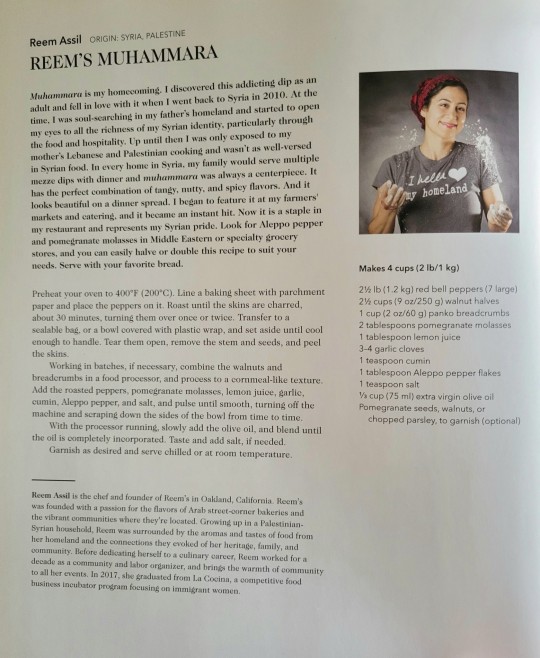






Full page transcripts under the cut:
Recipe #1: Reem's Muhammara
Photo Credit: Jung Fitzpatrick Photography and Ricarius Photography
"Muhammara is my homecoming. I discovered this addicting dip as an adult and fell in love with it when I went back to Syria in 2010. At the time, I was soul-searching in my father's homeland and started to open my eyes to all the richness of my Syrian identity, particularly through the food and hospitality. Up until then I was only exposed to my mother's Lebanese and Palestinian cooking and wasn't well-versed in Syrian food. In every home in Syria, my family would serve multiple mezze dips with dinner and muhammara was always a centerpiece. It has the perfect combination of tangy, nutty, and spicy flavors. And it looks beautiful on a dinner spread. I began to feature it at my farmers' markets and catering, and it became an instant hit. Now it is a staple in my restaurant and represents my Syrian pride. Look for Aleppo pepper and pomegranate molasses in Middle Eastern or specialty grocery stores, and you can easily halve or double this recipe to suit your needs. Serve with your favorite bread."
Makes 4 cups (2 lb / 1 kg)
Ingredients:
2 1/2 lb (1.2 kg) red bell peppers (7 large)
2 1/2 cups (9 oz / 250 g) walnut halves
1 cup (2 oz / 60 g) panko breadcrumbs
2 tablespoons pomegranate molasses
1 tablespoon lemon juice
3-4 garlic cloves
1 teaspoon cumin
1 tablespoon Aleppo pepper flakes
1 teaspoon salt
1/3 cup (75 ml) extra virgin olive oil
Pomegranate seeds, walnuts, or chopped parsley, to garnish optional)
Directions:
Preheat your oven to 400F (200C). Line a baking sheet with parchment paper and place the peppers on it. Roast until the skins are charred, about 30 minutes, turning them over once or twice. Transfer to a sealable bag, or a bowl covered with plastic wrap, and set aside until cool enough to handle. Tear them open, remove the stem and seeds, and peel the skins.
Working in batches, if necessary, combine the walnuts and breadcrumbs in a food processor, and process to a cornmeal-like texture. Add the roasted peppers, pomegranate molasses, lemon juice, garlic, cumin, Aleppo pepper, and salt, and pulse until smooth, turning off the machine and scraping down the sides of the bowl from time to time.
With the processor running, slowly add the olive oil, and blend until the oil is completely incorporated. Taste and add salt, if needed.
Garnish as desired and serve chilled or at room temperature.
"Reem Assil is the chef and founder of Reem's in Oakland, California. Reem's was founded with a passion for the flavors of Arab street-corner bakeries and the vibrant communities where they're located. Growing up in a Palestinian-Syrian household, Reem was surrounded by the aromas and tastes of food from her homeland and the connections they evoked of her heritage, family, and community. Before dedicating herself to a culinary career, Reem worked for a decade as a community and labor organizer, and brings the warmth of community to all her events. In 2017, she graduated from La Cocina, a competitive food business incubator program focusing on immigrant women."
Recipe #2: Gazan Hot Tomato And Dill Salad
Dagga (Salata Ghazawiyya)
Photo Credit: Ricarius Photography
"This is the most frequently served salad in Gaza, with a hot ite that makes it a fantastic accompaniment to meaty stews or rice dishes. Dagga, which is a variation of the work meaning "pounded" in Arabic, is commonly scooped up with Arabic bread, and has a consistency similar to that of a Mexican salsa. This dish must be made in a mortar and pestle with a rough interior (in Gaza, a zibdiya). Don't bother using a food processor!
Though she herself was of mixed Circassian and Kurdish-Damascene ancestry, my late maternal grandmother, il-Sitt Laila, as she was endearingly known, was fond of this classic, and used to refer to it as "the centerpiece of the Gazan table." It was probably the first recipe I learned from my mother, who often tasked us young children with the rhythmic exercise of mashing garlic.
Dagga is one of those recipes you are likely to find Gazan Palestinians making the world over, probably in a zibdiya they've inherited, a great source of pride. The original mortars are extremely hard to come by due to constant closures. They are fashioned from the rich, red clay in Gaza, and a constant reminder that though we may be thousands of miles (and often an unattainable reality) away, we have a part of that earth with us, and we can taste home wherever we go.
You can substitute 1 tablespoon dill seeds for the fresh dill and 2 tablespoons finely chopped onions for the garlic. The dill seeds should be ground in the mortar thoroughly in a circular motion along with some of the salt, before adding the onions and proceeding with the recipe."
Serves 4
Ingredients:
2 garlic cloves, peeled
1/2 teaspoon salt
2-3 hot green chili peppers, such as jalapeno or serrano
1/4 cup (1/2 oz / 15 g) finely chopped dill
3 ripe medium tomatoes, coarsely chiopped
Juice of 1/2 lemon
Extra virgin olive oil
Arabic flatbread or pita, to serve
Directions:
Using a large mortar and pestle, mash garlic and salt to a paste. Coarsely chop up the chili peppers, removing some of the membranes if you prefer less heat. Add the peppers to the mortar and crush until tender. Stir in the dill. Using circular motion, grind the dill until fragrant.
Add the tomatoes and pound until salad reaches a thick salsa-like consistency. Transfer to a serving dish, stir in the lemon juice, and then mix the entire salad well and even out the top with the back of a spoon. Drench the top with a rich olive oil, but don't stir it in.
Serve with Arabic flatbread on the side for scooping it up.
"Laila El-Haddad is a Maryland-based freelance journalist, documentarian, and cookbook author. She is the author of The Gaza Kitchen: A Palestinian Culinary Journey. She frequently writes on the intersection of food and politics and she is currently working on a book about the history of Islam in America, as told through food."
Recipe #3: Baked Fish Kibbeh
Kibbet Samak
Photo Credit: Ricarius Photography
"Growing up in Nazareth, we seldom ate red meat on Friday. The cafeteria at my elementary school would frequently serve mujaddara (lentil pilaf), which grew monotonous week after week. After school, my cousin Aida would take me to her house where my aunt Um Sami would feed us her delicious fish kibbeh. Hers was the only other cooking my mother really respected. And since Um Sami was on a first-name basis with the local fisherman, she always used the freshest catch.
A few summers ago, my family and I were on our annual deep-sea fishing trip to Montauk Point, New York, and as is our custom, we caught and enormous amount of fish. When I was trying to figure out creative ways to use it all, my aunt's recipe came to mind. It is a wonderful dish for a party, and this recipe can be easily doubled. It it best served with fattoush."
Serves 6 to 8
Ingredients:
SEASONING
1 tablespoon saly
1 1/2 tablespoon allspice
1 1/2 teaspoons cumin
1 1/2 teaspoons ground black pepper
1/4 teaspoon cinnamon
Pinch nutmeg
3/4 teaspoon dried marjoram
Zest of 1/2 lemon
Zest of 1/2 lime
Zest of 1/2 orange
SHELL
1 1/2 cups (8 oz / 225 g) extra-fine bulgur (size 0)
1/2 small white onion, coarsely chopped
1 1/2 lb (700 g) skinless grouper fillet or other firm white fish, cut into chunks
1 tablespoon hot pepper paste (optional)
STUFFING
1 1/2 (700 g) skinless striped bass fillet or other flaky white fish cut into 1 inch (2 cm) pieces
Salt
1/2 cup (120 ml) vegetable oil
1/4 cup (60 ml) olive oil, plus more for oiling
2 medium white onions, diced
2 shallots, diced
1/2 cup (1 oz / 30 g) chopped cilantro, plus more to garnish
1 tablespoon pomegranate or grape molasses or citrus juice
1 1/2 tablespoons lemon juice
1/2 cup (1 3/4 oz / 50 g) slivered almonds, toasted or fried, plus a few more to garnish
1/4 cup (1 1/2 oz / 40 g) pine nuts, toasted or fried
Directions:
Combine the spices and zest for the seasoning. Divide the mixture in half; half will be for your shell, and half for the stuffing.
Next, make the shell: Place the bulgur in a large bowl and add enough water to cover the bulgur by 1/4 inch (6 mm). Set aside until it absorbs the water, about 30 minutes.
Place the onions in the bowl of a food processor and process until very finely chopped. Remove and set aside. Place the grouper in the food processor and process to the consistency of a paste. In a large bowl, combine the onion, fish, and plumped bulgur. Mix in the hot pepper paste, and the spice-zest mixture you set aside for the shell.
Prepare a bowl of ice water. Dipping your hands in the ice water to prevent sticking, knead the mixture between your palms until it becomes dough-like. Cover and refrigerate.
Next, make the stuffing: Sprinkle 1/4 teaspoon of the spice mixture onto the fish with a small pinch of salt. Heat the vegetable oil in a large, heavy-bottomed saucepan over high heat. Fry the fish in batches, gently turning occasionally, until lightly browned on all sides, approximately 8 minutes. Transfer the cooked fish to a plate lined with paper towels.
Pour out the vegetable oil. In the same pan, heat the olive oil over medium heat. Saute the onions and shallots, stirring, until they are translucent and lightly browned, about 15 minutes. Add the cilantro and cook, stirring, for 2 to 3 more minutes. Add the fried fish, molasses, lemon juice, toasted nuts, and remaining spice mixture. Stir well, remove from the heat, and taste, adding salt, if needed. Allow to cool to room temperature.
Preheat the oven to 350F (180C). Coat a 13 inch by 9 inch (33 cm by 23 cm) glass or ceramic oven fish with 1 to 2 tablespoons olive oil. Remove the shell from the refrigerator and divide into halves. Use one batch to evenly line the bottom and sides of the baking dish. Evenly spread the stuffing on top of the shell. Spread the remaining shell paste over the top, pressing it with cold damp hands to level and seal the edges. Use a knife to score just the top layer into portions. Additional designed can be carved into each portion (usually rectangles or triangles).
Bake until cooked through and golden brown, 30 to 40 minutes. Remove from the oven and let cool for 15 minutes before serving, so the portions hold their shape. Garnish with chopped cilantro and almonds, if desired.
"Rawa Bishara is a chef and co-owner of Tanoreen restaurant in Bay Ridge, Brooklyn. She emigrated from her hometown in Nazareth to New York 40 years ago. She is the author of Olives, Lemons & Za'atar, published in 2014. Her second cookbook will be released in 2018."
7 notes
·
View notes
Text
Discussing Payment Processing in Canada, After-Effects of Covid, & Building a Business the Right Way
Article by Jonathan Bomser | CEO | Accept-Credit-Cards-Now.com

In the ever-evolving realm of commerce and business, payment processing remains an essential pillar of any enterprise. The COVID-19 pandemic acted as a catalyst for the rapid adoption of digital payments, underscoring the significance of merchant account processing and the secure, efficient acceptance of credit cards. In Canada, a nation celebrated for its strong economy and diverse business landscape, understanding the nuances of payment processing is fundamental for building a thriving business the right way.
Payment Processing in Canada: An In-Depth View
Canada, renowned for its tech-savvy and innovative populace, has been quick to embrace modern payment processing solutions. With a population that values convenience and security, businesses in the land of the maple leaf have had to evolve to meet these ever-evolving expectations.
Merchant account processing, the bedrock of payment acceptance, has witnessed substantial growth in Canada. This service enables businesses to accept credit cards, ensuring a seamless and secure transaction process for customers. Whether you're a brick-and-mortar store, a digital e-commerce platform, or a service-oriented business, having a dependable merchant account is the cornerstone of success.
The Post-COVID Impact on Payment Processing
The repercussions of the COVID-19 pandemic, which led to widespread economic turbulence, prompted businesses to reassess their payment processing strategies in Canada. The aftermath left several notable effects:
Surge in Contactless Payments: Concerns about hygiene sparked a surge in the popularity of contactless payments and mobile wallets. Canadians embraced tap-and-go payments, highlighting the necessity of offering these options to customers.
E-commerce Renaissance: With people staying home, e-commerce experienced a substantial resurgence. Businesses had to enhance their online payment processing capabilities to meet the surging demand.
Elevated Emphasis on Security: The surge in digital transactions amplified the importance of robust security measures. Canadians now expect their payment data to be handled with the utmost care, making secure payment processing a non-negotiable requirement.
Support for Small Businesses: Government initiatives and support programs aided small businesses, emphasizing the need for accessible and cost-effective payment processing solutions to not only survive but thrive.
youtube
Building a Business the Right Way: Payment Processing Edition
In the post-COVID era, businesses looking to thrive in Canada must focus on constructing a solid foundation for payment processing. Here are some pivotal steps:
Opt for the Right Payment Processor: Select a payment processor or merchant service provider that aligns with your business needs. Look for one offering competitive rates, outstanding customer support, and a diverse array of payment options to cater to your customers.
Prioritize Security: Security is paramount. Ensure your payment processing system adheres to industry standards and invest in measures to safeguard customer data. In Canada, compliance with the Payment Card Industry Data Security Standard (PCI DSS) is a fundamental requirement.
Seamless Integration: Regardless of whether you operate online, in a physical location, or both, your payment processing system should seamlessly integrate with your existing operations. This guarantees a smooth experience for both you and your customers.
Stay Informed: Payment processing is an ever-evolving field. Stay up-to-date on industry trends and technological advancements. Being aware of emerging payment options and understanding consumer preferences can provide your business with a competitive advantage.
Customer-Centric Approach: Place the customer at the heart of your payment processing strategy. Offer multiple payment options to accommodate their preferences, whether it's credit cards, mobile wallets, or emerging payment technologies.
For those seeking to accept credit cards, it's essential to remember that a robust merchant account processing system is your gateway to success in the modern Canadian business environment. Embrace change, prioritize security, and always place your customers at the forefront of your strategy.
#high risk merchant account#high risk payment gateway#high risk payment processing#merchant processing#payment processing#credit card payment#credit card processing#accept credit cards#payment#youtube#Youtube
19 notes
·
View notes
Text
Dead darlings tag
The kind and talented @winterandwords tagged me to post one of the darlings I had to kill (or as they put it, "a snippet that didn't make it into the latest draft of a story").
Thanks for the tag, I have a good one for you!
“Find your repurpose,” Dawson grumbled, rolling the wheel of her car toward the OPEN HOUSE sign. There was a cookie-cutter, carbon-copy sign on every street for ten or twenty blocks that said those same three words. “Find your repurpose.” They appeared overnight, the night before her rent control was lifted.
“Better than affordable housing,” the recruiter had said. (He had been plastering her workplace with flyers for hours, making sure that he did not miss an inch of poorly-mortared brick.) “300 sq. ft. can be so much more than you’ll ever need.”
“More than you’ll ever want.”
“That’s why they call them Forever Homes.”
Insufferable, carbon-copy recruiter. A man who would apparate in your bathroom if you turned off the lights and said “Old Navy” three times in a row.
Forever Homes never needed him to begin with. Not once did his freshly-pressed polo shirt convince a business man to walk into a repurposed shipping container and never walk out again. Not once did his carbon-copy signs make a woman turn away from pilates class to see what it might be like to forget the smell of fresh air and dandelions. What sold people, impoverished people, was the freedom from basic human needs. Food and shelter in exchange for whatever mark you might have made on this earth. There was no competition between sunshine and a full belly.
Then, there were the advertisements… the ones of the brown-eyed girl who had been living on the streets her whole life, walking into a Forever Home that slotted in furniture to depict a toy store where every teddy bear and baby doll was free– the one in which she picked up a bear the size of herself and they waddled into the next room to see a feast of lobster mac and cheese, shrimp gumbo, collared greens. She laughed deliriously and swung her bear up to see the treasure they had found.
Dawson had no daughter, she just…
She needed to be happy– childishly happy. She needed to eat lobster mac and cheese and hold a bear the size of herself, whether she was in her thirties, her teens, her terrible twos… She deserved that, didn’t she?
“So glad you could come check out–”
Dawson shoved past the Old Navy man, knocking him into a poorly concealed tower of hydraulic delivery systems. They were the things that carried the shelves, tables, and frivolous things around. She opened the door to the house, proclaimed as OPEN, and looked around to see nothing but an empty, off-white shipping container with subtle slits here and there.
“Where’s the ON switch?”
He cleared his throat.
“Voice control keywords are on the blue poster, but if you...”
She slammed the door before he could stick his foot in it.
For good measure, she leaned her weight against the door a while, in case he tried to barge in, uninvited. She knew he was only doing a job, but he was still a human with thoughts and feelings, and she would prefer that those thoughts and feelings never perceived her: a butch 32-year-old, sobbing into the teddy bear from the Forever Homes commercials.
From the outside, the recruiter only heard the hissing of hydraulics and clanking of metal furniture being pushed in and out of place.
Not a whimper could be heard from the outside. Not a word.
She emerged with a chapped nose and glassy eyes.
“How did you like…?”
“Yeah. It was fine, yeah.”
Her frown was as forced as his smile.
“Well, you can always come back if you change your mind.”
“Sure. I’ll think about it.”
Tagging @thecatsgravewrites, @literarynecromancy, and anyone who's read this far!
#writeblr#writers on tumblr#writing#my writing#snippets#writeblr tag games#tag games#from ellie#long post#foreverhomes
8 notes
·
View notes